Strategic Management: A Case Study of LVMH in the Top-Range Watch Industry
VerifiedAdded on 2024/07/03
|22
|4360
|136
AI Summary
This report examines the strategic management practices of LVMH, a luxury conglomerate, within the top-range watch industry. It critically analyzes the main characteristics of the industry, the challenges faced by companies, and LVMH's competitive position. The report explores relevant theories like Porter's Five Forces and Ansoff's Matrix to understand LVMH's strategic decisions and their impact on its success in the luxury market. It also discusses the factors contributing to LVMH's overall success in the luxury sector.
Contribute Materials
Your contribution can guide someone’s learning journey. Share your
documents today.

Secure Best Marks with AI Grader
Need help grading? Try our AI Grader for instant feedback on your assignments.
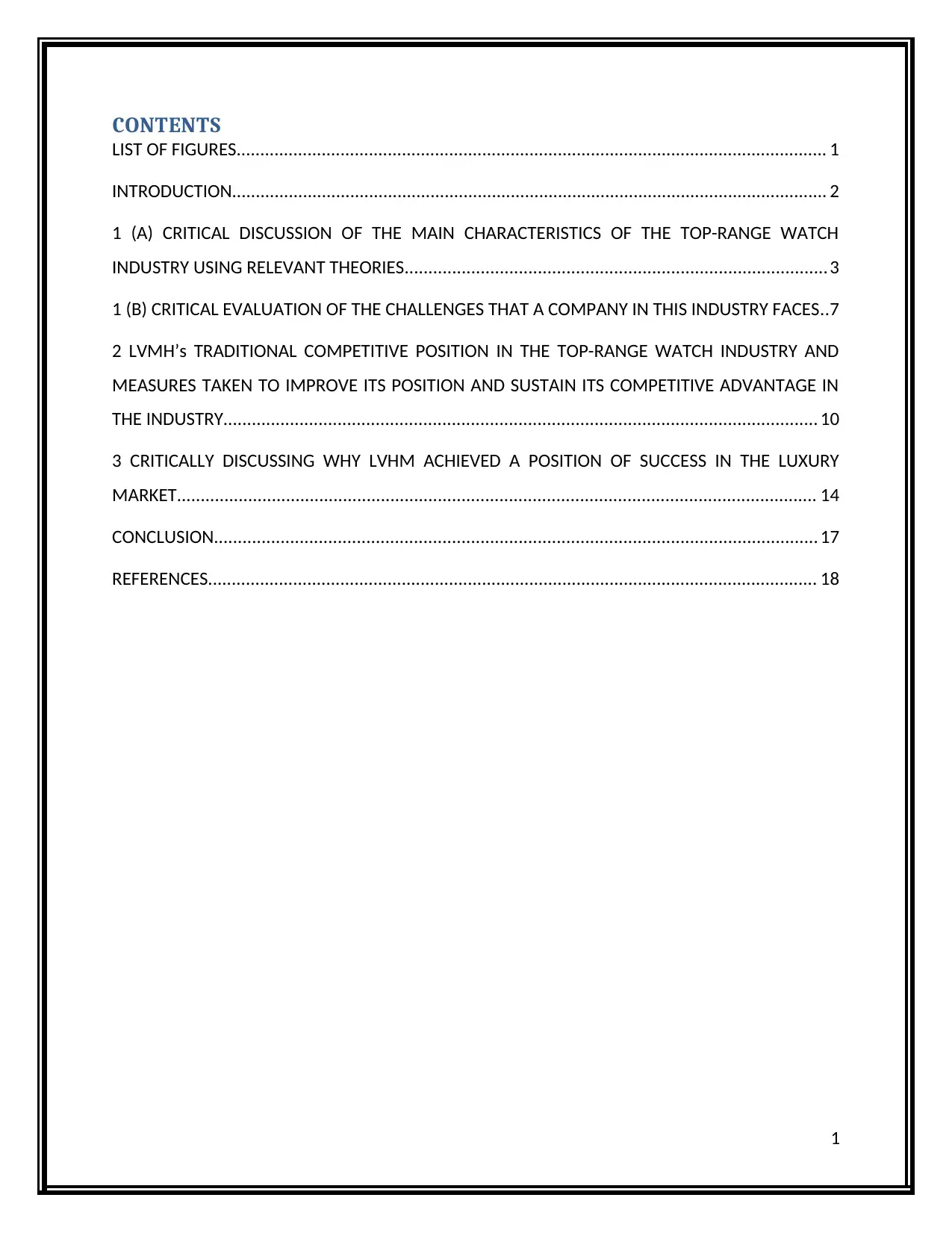
CONTENTS
LIST OF FIGURES............................................................................................................................. 1
INTRODUCTION.............................................................................................................................. 2
1 (A) CRITICAL DISCUSSION OF THE MAIN CHARACTERISTICS OF THE TOP-RANGE WATCH
INDUSTRY USING RELEVANT THEORIES......................................................................................... 3
1 (B) CRITICAL EVALUATION OF THE CHALLENGES THAT A COMPANY IN THIS INDUSTRY FACES..7
2 LVMH’s TRADITIONAL COMPETITIVE POSITION IN THE TOP-RANGE WATCH INDUSTRY AND
MEASURES TAKEN TO IMPROVE ITS POSITION AND SUSTAIN ITS COMPETITIVE ADVANTAGE IN
THE INDUSTRY............................................................................................................................. 10
3 CRITICALLY DISCUSSING WHY LVHM ACHIEVED A POSITION OF SUCCESS IN THE LUXURY
MARKET....................................................................................................................................... 14
CONCLUSION............................................................................................................................... 17
REFERENCES................................................................................................................................. 18
1
LIST OF FIGURES............................................................................................................................. 1
INTRODUCTION.............................................................................................................................. 2
1 (A) CRITICAL DISCUSSION OF THE MAIN CHARACTERISTICS OF THE TOP-RANGE WATCH
INDUSTRY USING RELEVANT THEORIES......................................................................................... 3
1 (B) CRITICAL EVALUATION OF THE CHALLENGES THAT A COMPANY IN THIS INDUSTRY FACES..7
2 LVMH’s TRADITIONAL COMPETITIVE POSITION IN THE TOP-RANGE WATCH INDUSTRY AND
MEASURES TAKEN TO IMPROVE ITS POSITION AND SUSTAIN ITS COMPETITIVE ADVANTAGE IN
THE INDUSTRY............................................................................................................................. 10
3 CRITICALLY DISCUSSING WHY LVHM ACHIEVED A POSITION OF SUCCESS IN THE LUXURY
MARKET....................................................................................................................................... 14
CONCLUSION............................................................................................................................... 17
REFERENCES................................................................................................................................. 18
1
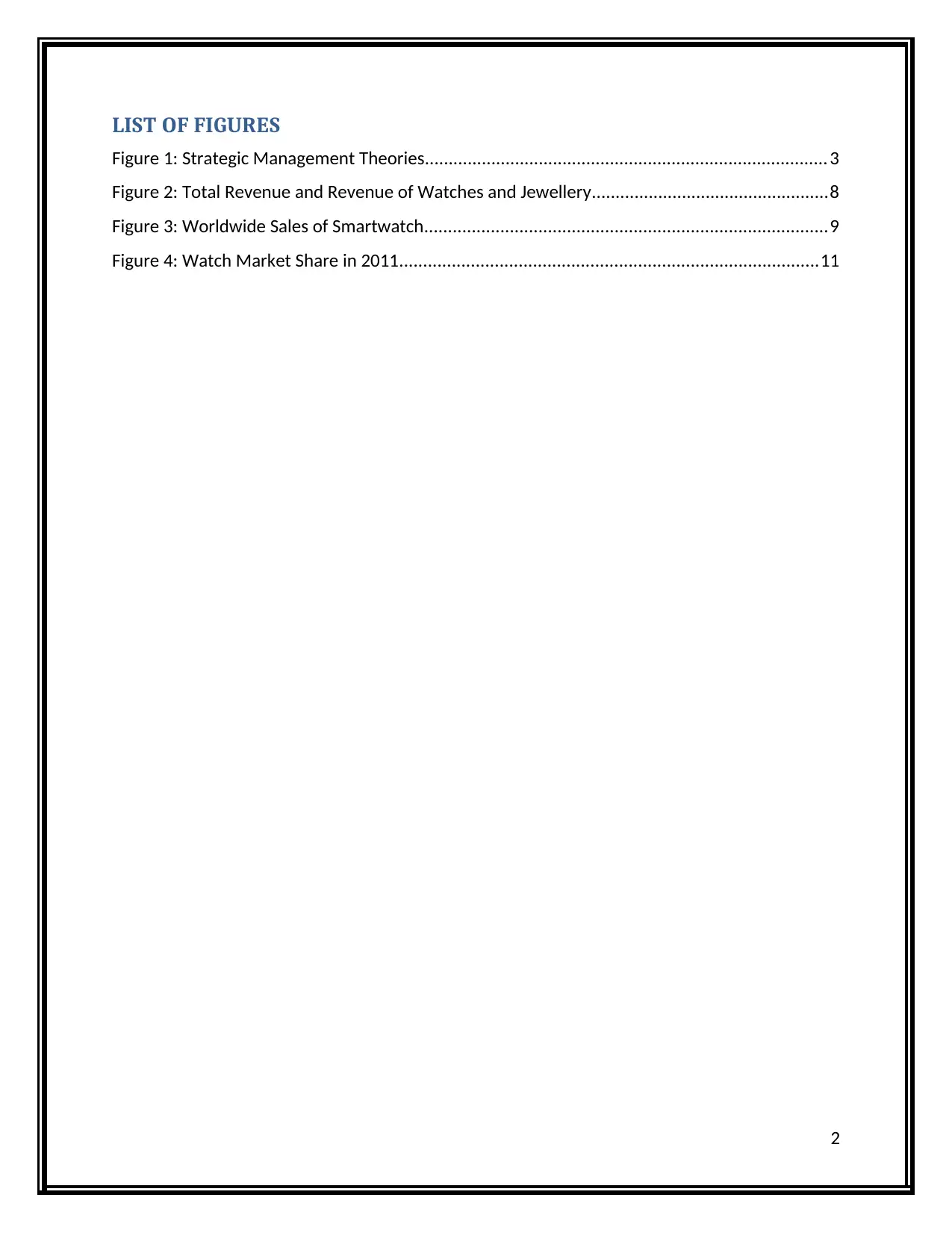
LIST OF FIGURES
Figure 1: Strategic Management Theories..................................................................................... 3
Figure 2: Total Revenue and Revenue of Watches and Jewellery..................................................8
Figure 3: Worldwide Sales of Smartwatch.....................................................................................9
Figure 4: Watch Market Share in 2011........................................................................................11
2
Figure 1: Strategic Management Theories..................................................................................... 3
Figure 2: Total Revenue and Revenue of Watches and Jewellery..................................................8
Figure 3: Worldwide Sales of Smartwatch.....................................................................................9
Figure 4: Watch Market Share in 2011........................................................................................11
2
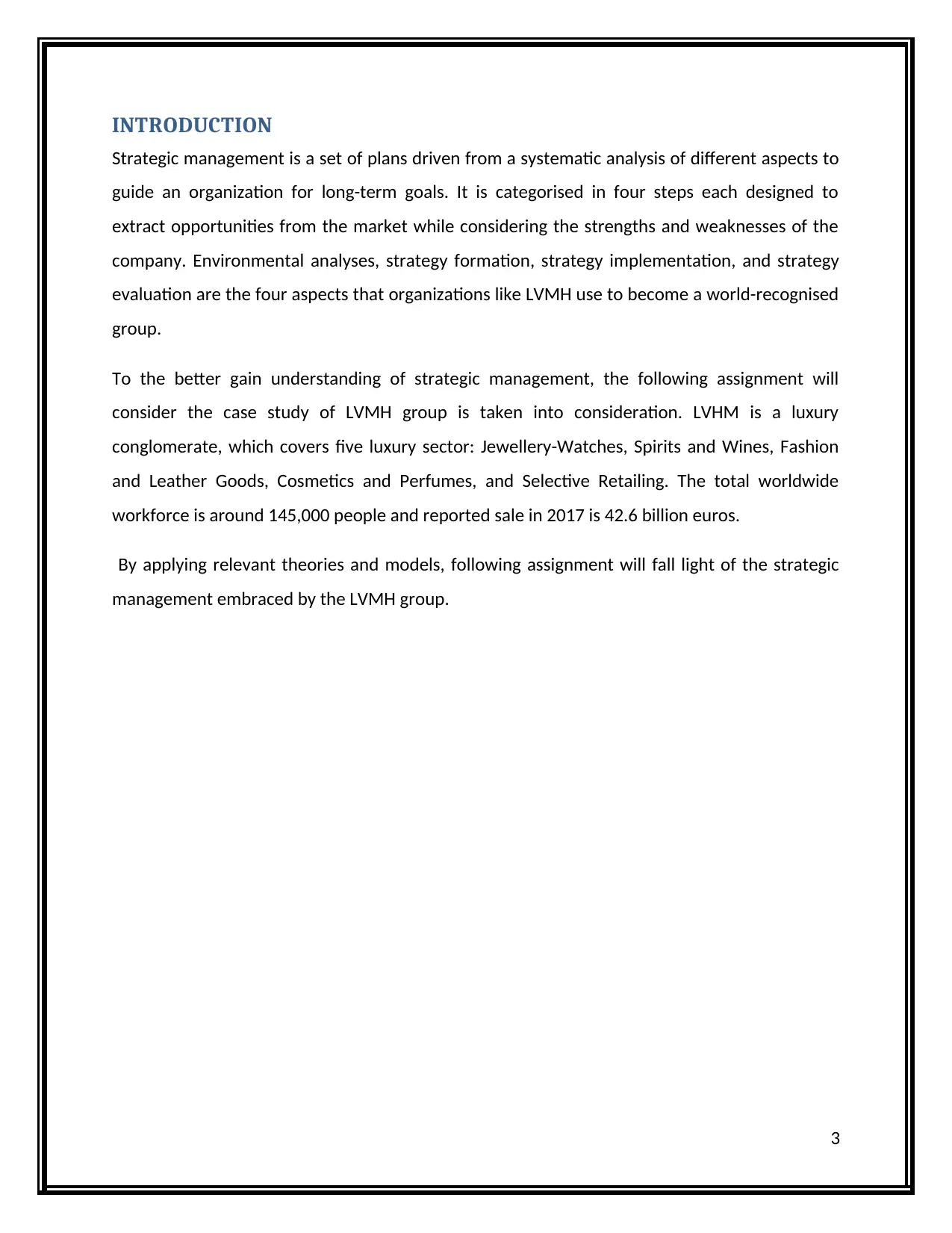
INTRODUCTION
Strategic management is a set of plans driven from a systematic analysis of different aspects to
guide an organization for long-term goals. It is categorised in four steps each designed to
extract opportunities from the market while considering the strengths and weaknesses of the
company. Environmental analyses, strategy formation, strategy implementation, and strategy
evaluation are the four aspects that organizations like LVMH use to become a world-recognised
group.
To the better gain understanding of strategic management, the following assignment will
consider the case study of LVMH group is taken into consideration. LVHM is a luxury
conglomerate, which covers five luxury sector: Jewellery-Watches, Spirits and Wines, Fashion
and Leather Goods, Cosmetics and Perfumes, and Selective Retailing. The total worldwide
workforce is around 145,000 people and reported sale in 2017 is 42.6 billion euros.
By applying relevant theories and models, following assignment will fall light of the strategic
management embraced by the LVMH group.
3
Strategic management is a set of plans driven from a systematic analysis of different aspects to
guide an organization for long-term goals. It is categorised in four steps each designed to
extract opportunities from the market while considering the strengths and weaknesses of the
company. Environmental analyses, strategy formation, strategy implementation, and strategy
evaluation are the four aspects that organizations like LVMH use to become a world-recognised
group.
To the better gain understanding of strategic management, the following assignment will
consider the case study of LVMH group is taken into consideration. LVHM is a luxury
conglomerate, which covers five luxury sector: Jewellery-Watches, Spirits and Wines, Fashion
and Leather Goods, Cosmetics and Perfumes, and Selective Retailing. The total worldwide
workforce is around 145,000 people and reported sale in 2017 is 42.6 billion euros.
By applying relevant theories and models, following assignment will fall light of the strategic
management embraced by the LVMH group.
3
Secure Best Marks with AI Grader
Need help grading? Try our AI Grader for instant feedback on your assignments.
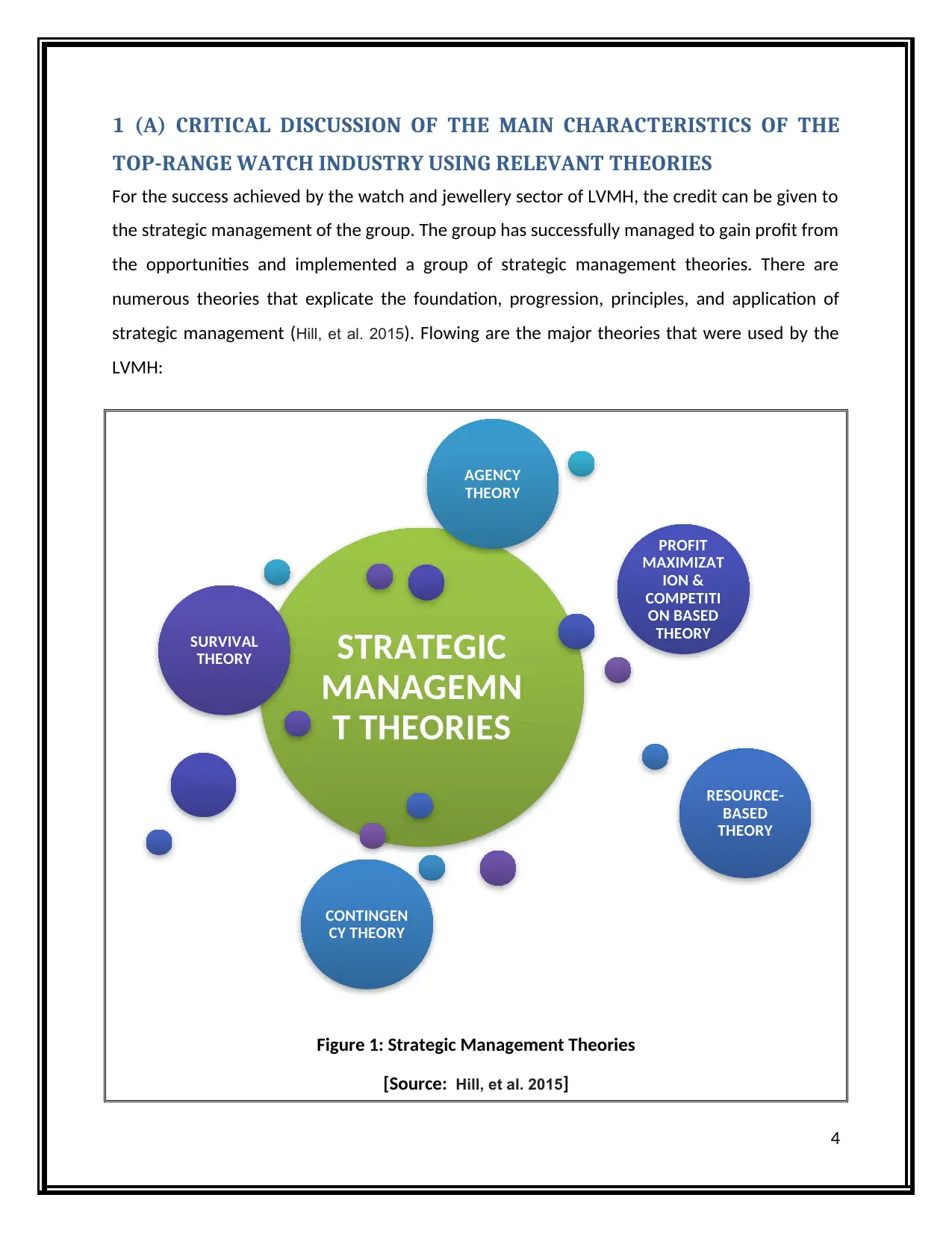
1 (A) CRITICAL DISCUSSION OF THE MAIN CHARACTERISTICS OF THE
TOP-RANGE WATCH INDUSTRY USING RELEVANT THEORIES
For the success achieved by the watch and jewellery sector of LVMH, the credit can be given to
the strategic management of the group. The group has successfully managed to gain profit from
the opportunities and implemented a group of strategic management theories. There are
numerous theories that explicate the foundation, progression, principles, and application of
strategic management (Hill, et al. 2015). Flowing are the major theories that were used by the
LVMH:
Figure 1: Strategic Management Theories
[Source: Hill, et al. 2015]
4
STRATEGIC
MANAGEMN
T THEORIES
SURVIVAL
THEORY
PROFIT
MAXIMIZAT
ION &
COMPETITI
ON BASED
THEORY
RESOURCE-
BASED
THEORY
CONTINGEN
CY THEORY
AGENCY
THEORY
TOP-RANGE WATCH INDUSTRY USING RELEVANT THEORIES
For the success achieved by the watch and jewellery sector of LVMH, the credit can be given to
the strategic management of the group. The group has successfully managed to gain profit from
the opportunities and implemented a group of strategic management theories. There are
numerous theories that explicate the foundation, progression, principles, and application of
strategic management (Hill, et al. 2015). Flowing are the major theories that were used by the
LVMH:
Figure 1: Strategic Management Theories
[Source: Hill, et al. 2015]
4
STRATEGIC
MANAGEMN
T THEORIES
SURVIVAL
THEORY
PROFIT
MAXIMIZAT
ION &
COMPETITI
ON BASED
THEORY
RESOURCE-
BASED
THEORY
CONTINGEN
CY THEORY
AGENCY
THEORY
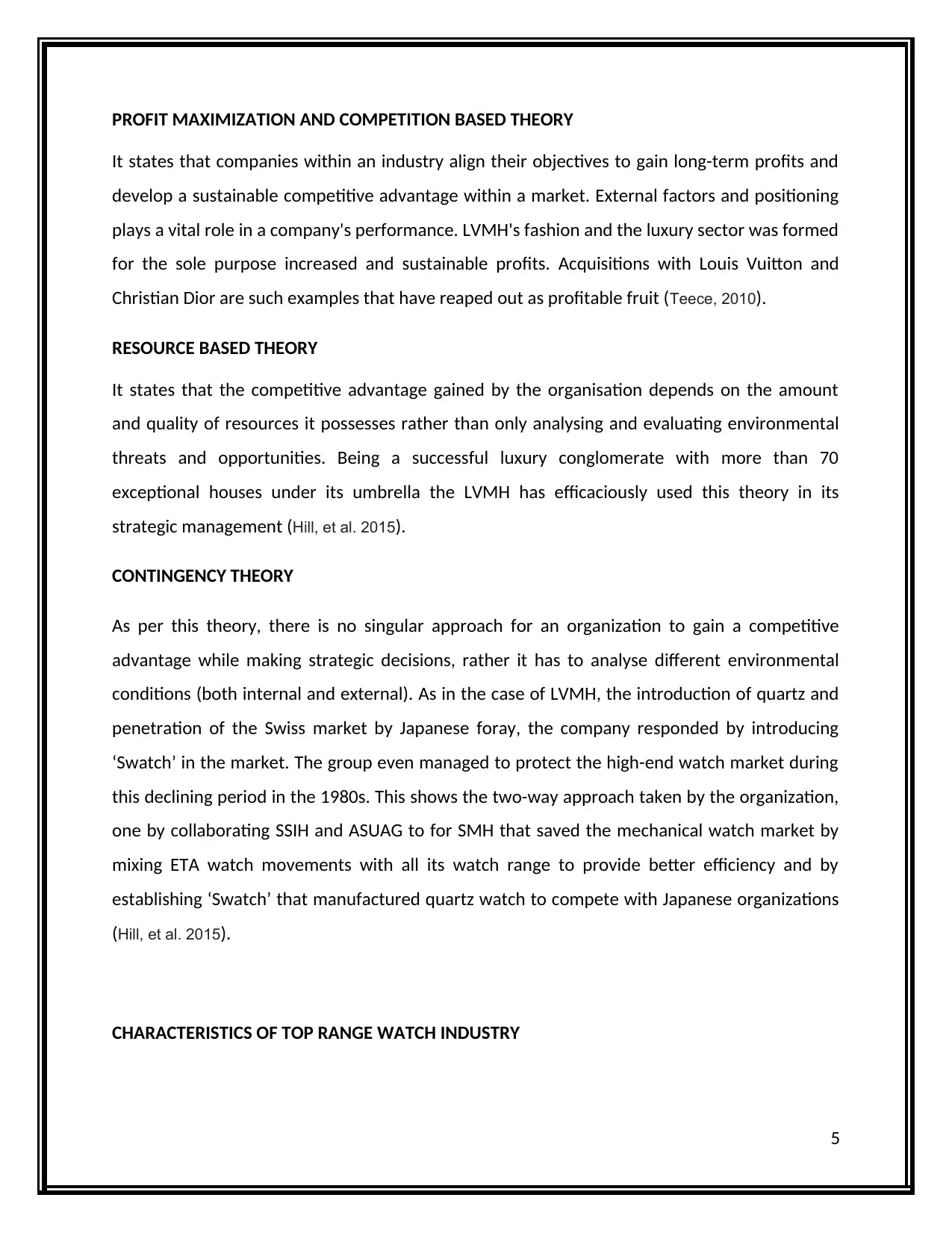
PROFIT MAXIMIZATION AND COMPETITION BASED THEORY
It states that companies within an industry align their objectives to gain long-term profits and
develop a sustainable competitive advantage within a market. External factors and positioning
plays a vital role in a company's performance. LVMH's fashion and the luxury sector was formed
for the sole purpose increased and sustainable profits. Acquisitions with Louis Vuitton and
Christian Dior are such examples that have reaped out as profitable fruit (Teece, 2010).
RESOURCE BASED THEORY
It states that the competitive advantage gained by the organisation depends on the amount
and quality of resources it possesses rather than only analysing and evaluating environmental
threats and opportunities. Being a successful luxury conglomerate with more than 70
exceptional houses under its umbrella the LVMH has efficaciously used this theory in its
strategic management (Hill, et al. 2015).
CONTINGENCY THEORY
As per this theory, there is no singular approach for an organization to gain a competitive
advantage while making strategic decisions, rather it has to analyse different environmental
conditions (both internal and external). As in the case of LVMH, the introduction of quartz and
penetration of the Swiss market by Japanese foray, the company responded by introducing
‘Swatch’ in the market. The group even managed to protect the high-end watch market during
this declining period in the 1980s. This shows the two-way approach taken by the organization,
one by collaborating SSIH and ASUAG to for SMH that saved the mechanical watch market by
mixing ETA watch movements with all its watch range to provide better efficiency and by
establishing ‘Swatch’ that manufactured quartz watch to compete with Japanese organizations
(Hill, et al. 2015).
CHARACTERISTICS OF TOP RANGE WATCH INDUSTRY
5
It states that companies within an industry align their objectives to gain long-term profits and
develop a sustainable competitive advantage within a market. External factors and positioning
plays a vital role in a company's performance. LVMH's fashion and the luxury sector was formed
for the sole purpose increased and sustainable profits. Acquisitions with Louis Vuitton and
Christian Dior are such examples that have reaped out as profitable fruit (Teece, 2010).
RESOURCE BASED THEORY
It states that the competitive advantage gained by the organisation depends on the amount
and quality of resources it possesses rather than only analysing and evaluating environmental
threats and opportunities. Being a successful luxury conglomerate with more than 70
exceptional houses under its umbrella the LVMH has efficaciously used this theory in its
strategic management (Hill, et al. 2015).
CONTINGENCY THEORY
As per this theory, there is no singular approach for an organization to gain a competitive
advantage while making strategic decisions, rather it has to analyse different environmental
conditions (both internal and external). As in the case of LVMH, the introduction of quartz and
penetration of the Swiss market by Japanese foray, the company responded by introducing
‘Swatch’ in the market. The group even managed to protect the high-end watch market during
this declining period in the 1980s. This shows the two-way approach taken by the organization,
one by collaborating SSIH and ASUAG to for SMH that saved the mechanical watch market by
mixing ETA watch movements with all its watch range to provide better efficiency and by
establishing ‘Swatch’ that manufactured quartz watch to compete with Japanese organizations
(Hill, et al. 2015).
CHARACTERISTICS OF TOP RANGE WATCH INDUSTRY
5
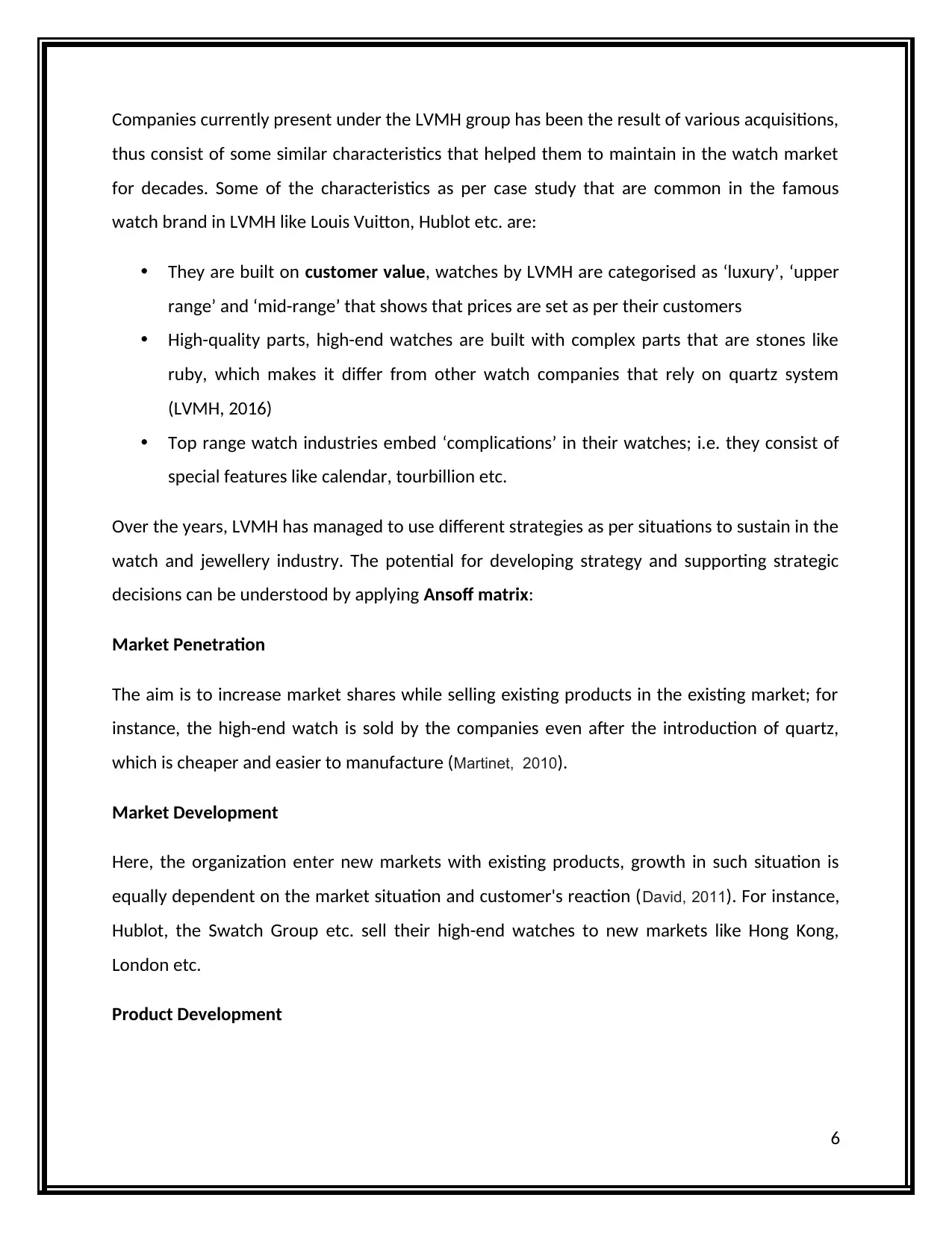
Companies currently present under the LVMH group has been the result of various acquisitions,
thus consist of some similar characteristics that helped them to maintain in the watch market
for decades. Some of the characteristics as per case study that are common in the famous
watch brand in LVMH like Louis Vuitton, Hublot etc. are:
They are built on customer value, watches by LVMH are categorised as ‘luxury’, ‘upper
range’ and ‘mid-range’ that shows that prices are set as per their customers
High-quality parts, high-end watches are built with complex parts that are stones like
ruby, which makes it differ from other watch companies that rely on quartz system
(LVMH, 2016)
Top range watch industries embed ‘complications’ in their watches; i.e. they consist of
special features like calendar, tourbillion etc.
Over the years, LVMH has managed to use different strategies as per situations to sustain in the
watch and jewellery industry. The potential for developing strategy and supporting strategic
decisions can be understood by applying Ansoff matrix:
Market Penetration
The aim is to increase market shares while selling existing products in the existing market; for
instance, the high-end watch is sold by the companies even after the introduction of quartz,
which is cheaper and easier to manufacture (Martinet, 2010).
Market Development
Here, the organization enter new markets with existing products, growth in such situation is
equally dependent on the market situation and customer's reaction (David, 2011). For instance,
Hublot, the Swatch Group etc. sell their high-end watches to new markets like Hong Kong,
London etc.
Product Development
6
thus consist of some similar characteristics that helped them to maintain in the watch market
for decades. Some of the characteristics as per case study that are common in the famous
watch brand in LVMH like Louis Vuitton, Hublot etc. are:
They are built on customer value, watches by LVMH are categorised as ‘luxury’, ‘upper
range’ and ‘mid-range’ that shows that prices are set as per their customers
High-quality parts, high-end watches are built with complex parts that are stones like
ruby, which makes it differ from other watch companies that rely on quartz system
(LVMH, 2016)
Top range watch industries embed ‘complications’ in their watches; i.e. they consist of
special features like calendar, tourbillion etc.
Over the years, LVMH has managed to use different strategies as per situations to sustain in the
watch and jewellery industry. The potential for developing strategy and supporting strategic
decisions can be understood by applying Ansoff matrix:
Market Penetration
The aim is to increase market shares while selling existing products in the existing market; for
instance, the high-end watch is sold by the companies even after the introduction of quartz,
which is cheaper and easier to manufacture (Martinet, 2010).
Market Development
Here, the organization enter new markets with existing products, growth in such situation is
equally dependent on the market situation and customer's reaction (David, 2011). For instance,
Hublot, the Swatch Group etc. sell their high-end watches to new markets like Hong Kong,
London etc.
Product Development
6
Paraphrase This Document
Need a fresh take? Get an instant paraphrase of this document with our AI Paraphraser
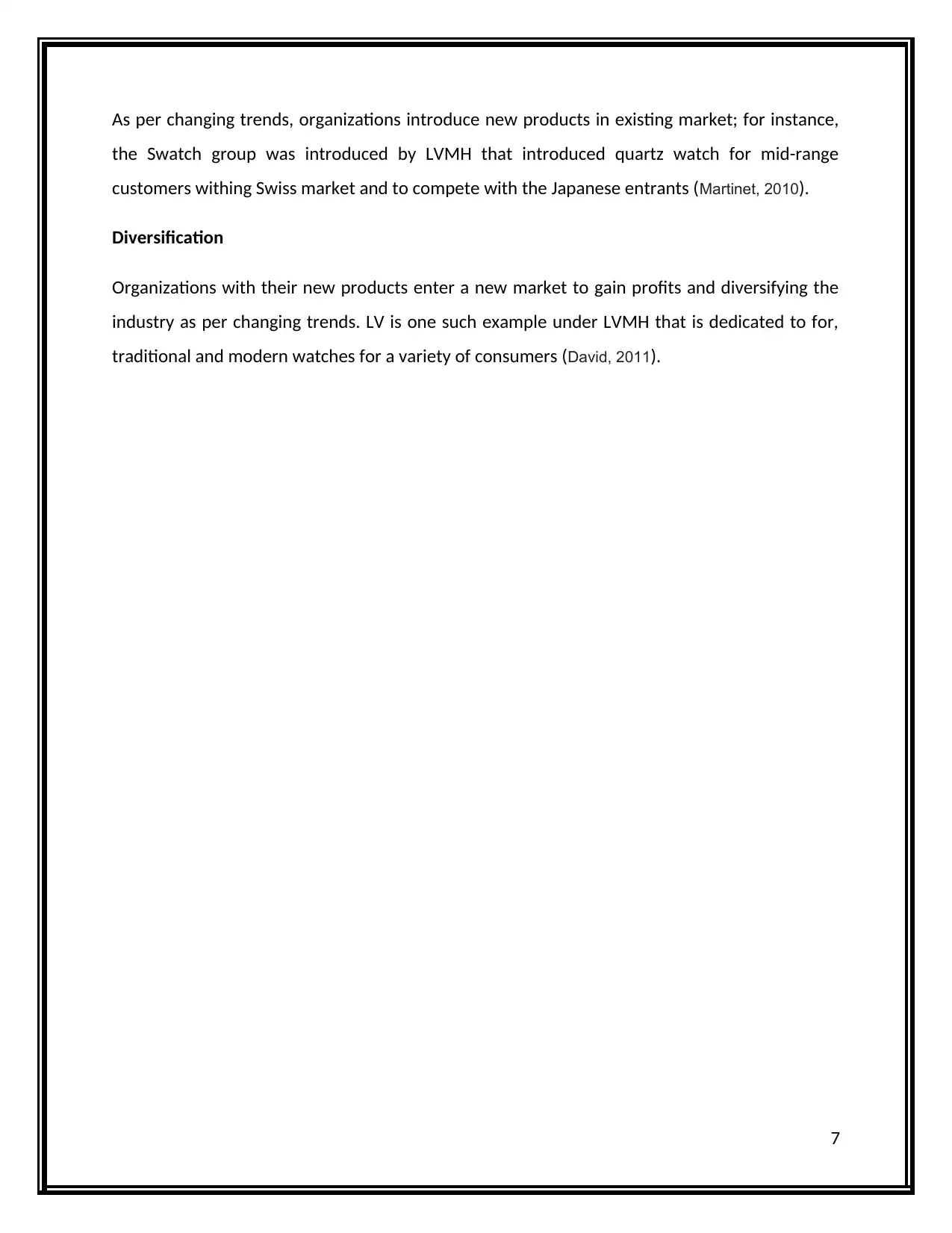
As per changing trends, organizations introduce new products in existing market; for instance,
the Swatch group was introduced by LVMH that introduced quartz watch for mid-range
customers withing Swiss market and to compete with the Japanese entrants (Martinet, 2010).
Diversification
Organizations with their new products enter a new market to gain profits and diversifying the
industry as per changing trends. LV is one such example under LVMH that is dedicated to for,
traditional and modern watches for a variety of consumers (David, 2011).
7
the Swatch group was introduced by LVMH that introduced quartz watch for mid-range
customers withing Swiss market and to compete with the Japanese entrants (Martinet, 2010).
Diversification
Organizations with their new products enter a new market to gain profits and diversifying the
industry as per changing trends. LV is one such example under LVMH that is dedicated to for,
traditional and modern watches for a variety of consumers (David, 2011).
7
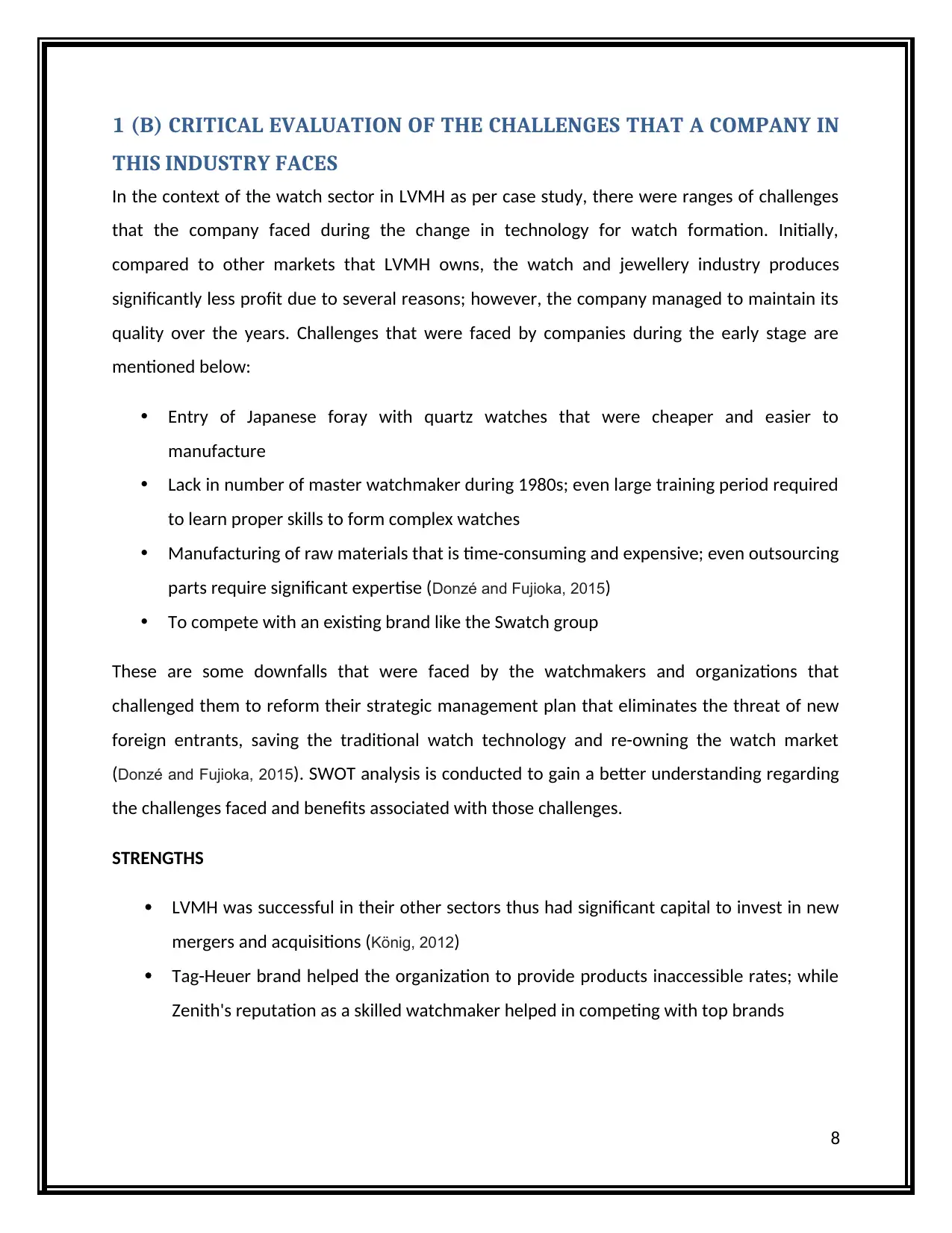
1 (B) CRITICAL EVALUATION OF THE CHALLENGES THAT A COMPANY IN
THIS INDUSTRY FACES
In the context of the watch sector in LVMH as per case study, there were ranges of challenges
that the company faced during the change in technology for watch formation. Initially,
compared to other markets that LVMH owns, the watch and jewellery industry produces
significantly less profit due to several reasons; however, the company managed to maintain its
quality over the years. Challenges that were faced by companies during the early stage are
mentioned below:
Entry of Japanese foray with quartz watches that were cheaper and easier to
manufacture
Lack in number of master watchmaker during 1980s; even large training period required
to learn proper skills to form complex watches
Manufacturing of raw materials that is time-consuming and expensive; even outsourcing
parts require significant expertise (Donzé and Fujioka, 2015)
To compete with an existing brand like the Swatch group
These are some downfalls that were faced by the watchmakers and organizations that
challenged them to reform their strategic management plan that eliminates the threat of new
foreign entrants, saving the traditional watch technology and re-owning the watch market
(Donzé and Fujioka, 2015). SWOT analysis is conducted to gain a better understanding regarding
the challenges faced and benefits associated with those challenges.
STRENGTHS
LVMH was successful in their other sectors thus had significant capital to invest in new
mergers and acquisitions (König, 2012)
Tag-Heuer brand helped the organization to provide products inaccessible rates; while
Zenith's reputation as a skilled watchmaker helped in competing with top brands
8
THIS INDUSTRY FACES
In the context of the watch sector in LVMH as per case study, there were ranges of challenges
that the company faced during the change in technology for watch formation. Initially,
compared to other markets that LVMH owns, the watch and jewellery industry produces
significantly less profit due to several reasons; however, the company managed to maintain its
quality over the years. Challenges that were faced by companies during the early stage are
mentioned below:
Entry of Japanese foray with quartz watches that were cheaper and easier to
manufacture
Lack in number of master watchmaker during 1980s; even large training period required
to learn proper skills to form complex watches
Manufacturing of raw materials that is time-consuming and expensive; even outsourcing
parts require significant expertise (Donzé and Fujioka, 2015)
To compete with an existing brand like the Swatch group
These are some downfalls that were faced by the watchmakers and organizations that
challenged them to reform their strategic management plan that eliminates the threat of new
foreign entrants, saving the traditional watch technology and re-owning the watch market
(Donzé and Fujioka, 2015). SWOT analysis is conducted to gain a better understanding regarding
the challenges faced and benefits associated with those challenges.
STRENGTHS
LVMH was successful in their other sectors thus had significant capital to invest in new
mergers and acquisitions (König, 2012)
Tag-Heuer brand helped the organization to provide products inaccessible rates; while
Zenith's reputation as a skilled watchmaker helped in competing with top brands
8
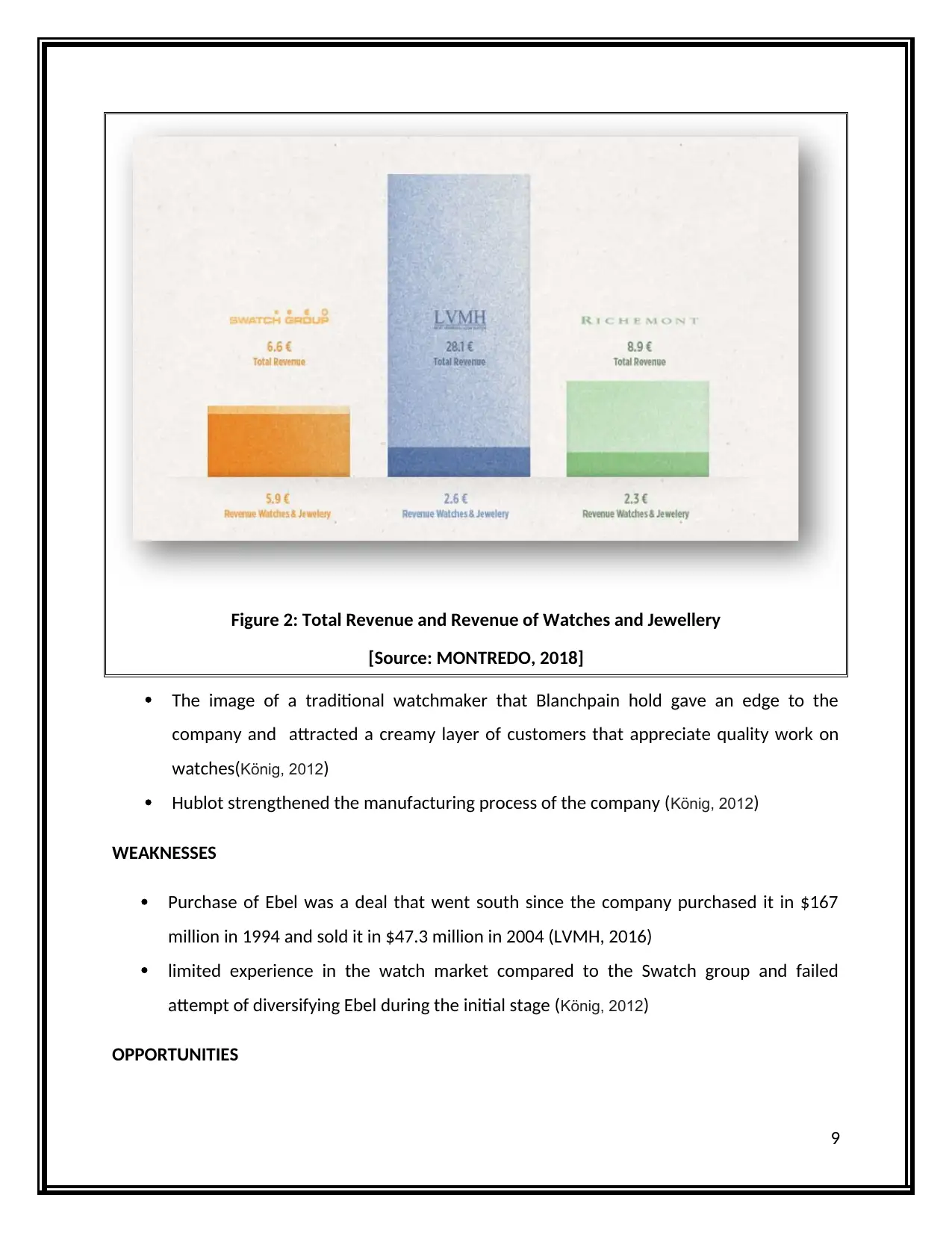
Figure 2: Total Revenue and Revenue of Watches and Jewellery
[Source: MONTREDO, 2018]
The image of a traditional watchmaker that Blanchpain hold gave an edge to the
company and attracted a creamy layer of customers that appreciate quality work on
watches(König, 2012)
Hublot strengthened the manufacturing process of the company (König, 2012)
WEAKNESSES
Purchase of Ebel was a deal that went south since the company purchased it in $167
million in 1994 and sold it in $47.3 million in 2004 (LVMH, 2016)
limited experience in the watch market compared to the Swatch group and failed
attempt of diversifying Ebel during the initial stage (König, 2012)
OPPORTUNITIES
9
[Source: MONTREDO, 2018]
The image of a traditional watchmaker that Blanchpain hold gave an edge to the
company and attracted a creamy layer of customers that appreciate quality work on
watches(König, 2012)
Hublot strengthened the manufacturing process of the company (König, 2012)
WEAKNESSES
Purchase of Ebel was a deal that went south since the company purchased it in $167
million in 1994 and sold it in $47.3 million in 2004 (LVMH, 2016)
limited experience in the watch market compared to the Swatch group and failed
attempt of diversifying Ebel during the initial stage (König, 2012)
OPPORTUNITIES
9
Secure Best Marks with AI Grader
Need help grading? Try our AI Grader for instant feedback on your assignments.
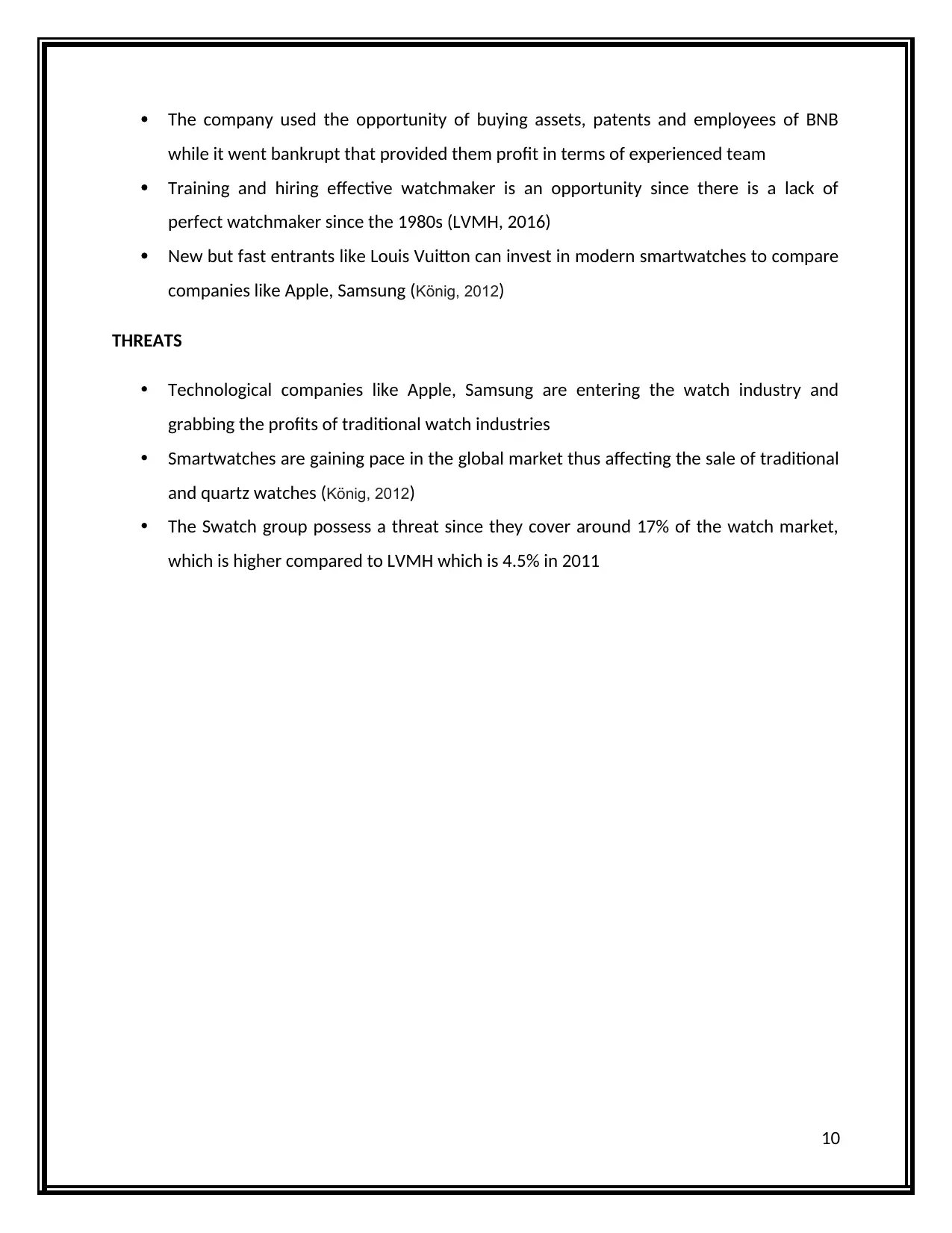
The company used the opportunity of buying assets, patents and employees of BNB
while it went bankrupt that provided them profit in terms of experienced team
Training and hiring effective watchmaker is an opportunity since there is a lack of
perfect watchmaker since the 1980s (LVMH, 2016)
New but fast entrants like Louis Vuitton can invest in modern smartwatches to compare
companies like Apple, Samsung (König, 2012)
THREATS
Technological companies like Apple, Samsung are entering the watch industry and
grabbing the profits of traditional watch industries
Smartwatches are gaining pace in the global market thus affecting the sale of traditional
and quartz watches (König, 2012)
The Swatch group possess a threat since they cover around 17% of the watch market,
which is higher compared to LVMH which is 4.5% in 2011
10
while it went bankrupt that provided them profit in terms of experienced team
Training and hiring effective watchmaker is an opportunity since there is a lack of
perfect watchmaker since the 1980s (LVMH, 2016)
New but fast entrants like Louis Vuitton can invest in modern smartwatches to compare
companies like Apple, Samsung (König, 2012)
THREATS
Technological companies like Apple, Samsung are entering the watch industry and
grabbing the profits of traditional watch industries
Smartwatches are gaining pace in the global market thus affecting the sale of traditional
and quartz watches (König, 2012)
The Swatch group possess a threat since they cover around 17% of the watch market,
which is higher compared to LVMH which is 4.5% in 2011
10
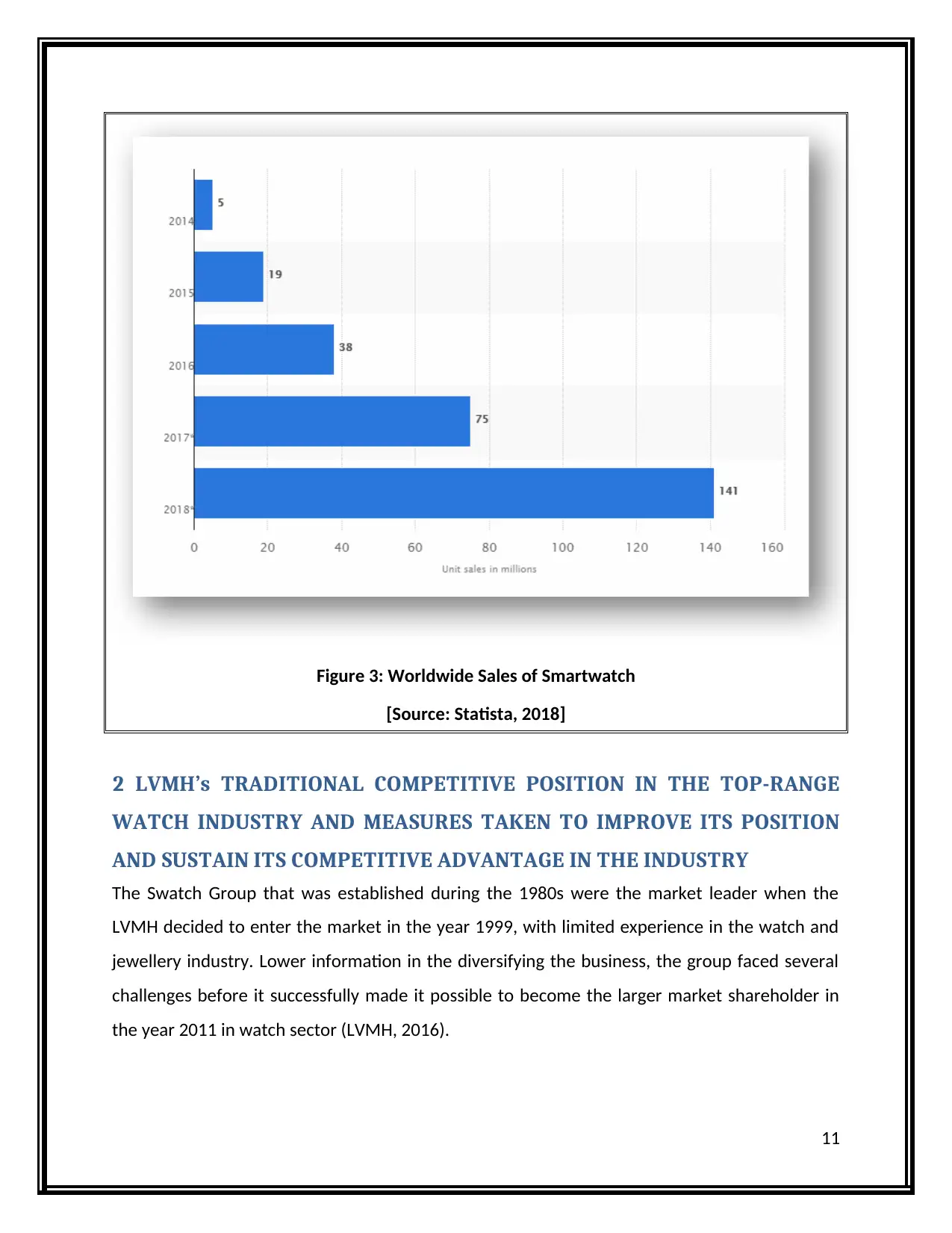
Figure 3: Worldwide Sales of Smartwatch
[Source: Statista, 2018]
2 LVMH’s TRADITIONAL COMPETITIVE POSITION IN THE TOP-RANGE
WATCH INDUSTRY AND MEASURES TAKEN TO IMPROVE ITS POSITION
AND SUSTAIN ITS COMPETITIVE ADVANTAGE IN THE INDUSTRY
The Swatch Group that was established during the 1980s were the market leader when the
LVMH decided to enter the market in the year 1999, with limited experience in the watch and
jewellery industry. Lower information in the diversifying the business, the group faced several
challenges before it successfully made it possible to become the larger market shareholder in
the year 2011 in watch sector (LVMH, 2016).
11
[Source: Statista, 2018]
2 LVMH’s TRADITIONAL COMPETITIVE POSITION IN THE TOP-RANGE
WATCH INDUSTRY AND MEASURES TAKEN TO IMPROVE ITS POSITION
AND SUSTAIN ITS COMPETITIVE ADVANTAGE IN THE INDUSTRY
The Swatch Group that was established during the 1980s were the market leader when the
LVMH decided to enter the market in the year 1999, with limited experience in the watch and
jewellery industry. Lower information in the diversifying the business, the group faced several
challenges before it successfully made it possible to become the larger market shareholder in
the year 2011 in watch sector (LVMH, 2016).
11
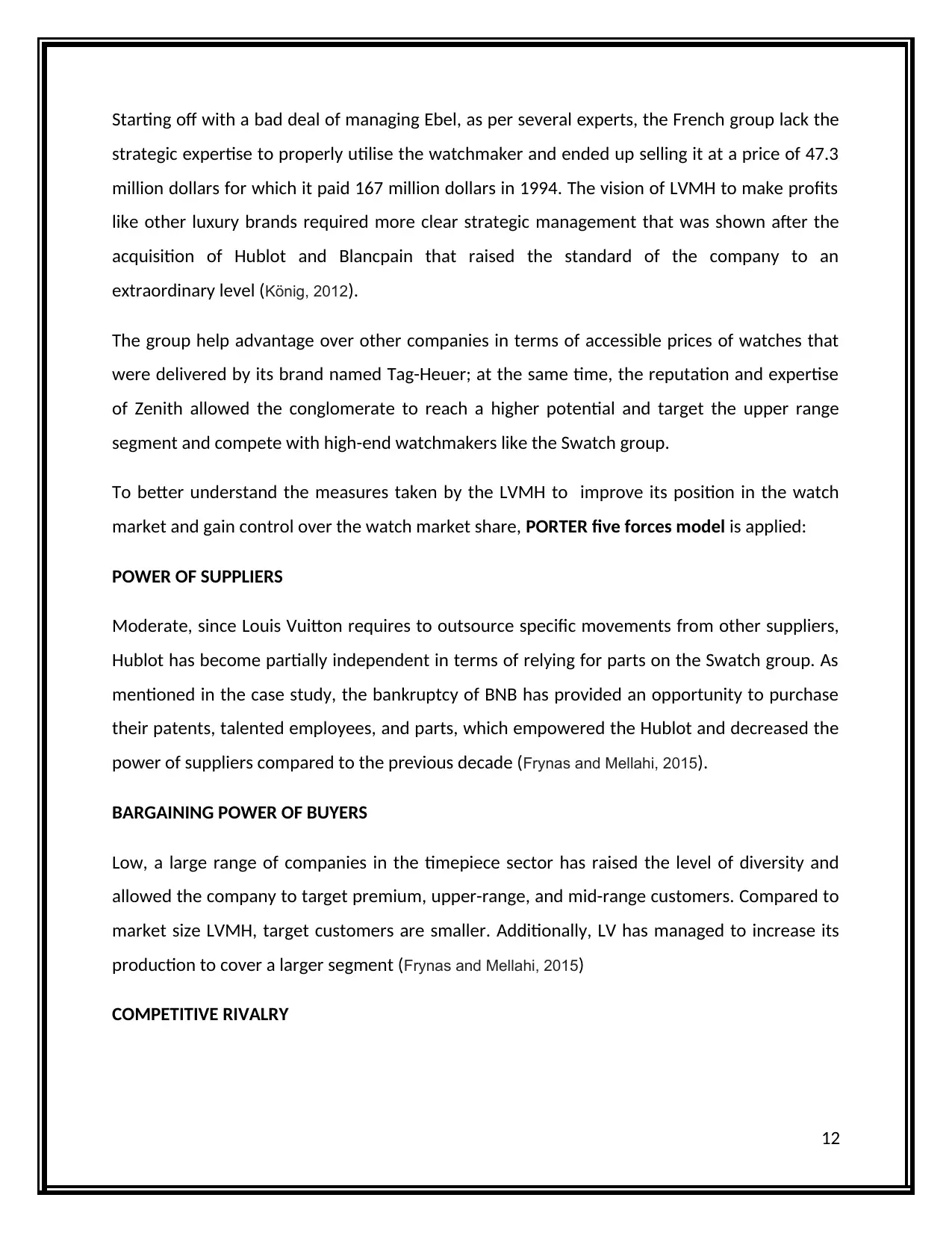
Starting off with a bad deal of managing Ebel, as per several experts, the French group lack the
strategic expertise to properly utilise the watchmaker and ended up selling it at a price of 47.3
million dollars for which it paid 167 million dollars in 1994. The vision of LVMH to make profits
like other luxury brands required more clear strategic management that was shown after the
acquisition of Hublot and Blancpain that raised the standard of the company to an
extraordinary level (König, 2012).
The group help advantage over other companies in terms of accessible prices of watches that
were delivered by its brand named Tag-Heuer; at the same time, the reputation and expertise
of Zenith allowed the conglomerate to reach a higher potential and target the upper range
segment and compete with high-end watchmakers like the Swatch group.
To better understand the measures taken by the LVMH to improve its position in the watch
market and gain control over the watch market share, PORTER five forces model is applied:
POWER OF SUPPLIERS
Moderate, since Louis Vuitton requires to outsource specific movements from other suppliers,
Hublot has become partially independent in terms of relying for parts on the Swatch group. As
mentioned in the case study, the bankruptcy of BNB has provided an opportunity to purchase
their patents, talented employees, and parts, which empowered the Hublot and decreased the
power of suppliers compared to the previous decade (Frynas and Mellahi, 2015).
BARGAINING POWER OF BUYERS
Low, a large range of companies in the timepiece sector has raised the level of diversity and
allowed the company to target premium, upper-range, and mid-range customers. Compared to
market size LVMH, target customers are smaller. Additionally, LV has managed to increase its
production to cover a larger segment (Frynas and Mellahi, 2015)
COMPETITIVE RIVALRY
12
strategic expertise to properly utilise the watchmaker and ended up selling it at a price of 47.3
million dollars for which it paid 167 million dollars in 1994. The vision of LVMH to make profits
like other luxury brands required more clear strategic management that was shown after the
acquisition of Hublot and Blancpain that raised the standard of the company to an
extraordinary level (König, 2012).
The group help advantage over other companies in terms of accessible prices of watches that
were delivered by its brand named Tag-Heuer; at the same time, the reputation and expertise
of Zenith allowed the conglomerate to reach a higher potential and target the upper range
segment and compete with high-end watchmakers like the Swatch group.
To better understand the measures taken by the LVMH to improve its position in the watch
market and gain control over the watch market share, PORTER five forces model is applied:
POWER OF SUPPLIERS
Moderate, since Louis Vuitton requires to outsource specific movements from other suppliers,
Hublot has become partially independent in terms of relying for parts on the Swatch group. As
mentioned in the case study, the bankruptcy of BNB has provided an opportunity to purchase
their patents, talented employees, and parts, which empowered the Hublot and decreased the
power of suppliers compared to the previous decade (Frynas and Mellahi, 2015).
BARGAINING POWER OF BUYERS
Low, a large range of companies in the timepiece sector has raised the level of diversity and
allowed the company to target premium, upper-range, and mid-range customers. Compared to
market size LVMH, target customers are smaller. Additionally, LV has managed to increase its
production to cover a larger segment (Frynas and Mellahi, 2015)
COMPETITIVE RIVALRY
12
Paraphrase This Document
Need a fresh take? Get an instant paraphrase of this document with our AI Paraphraser
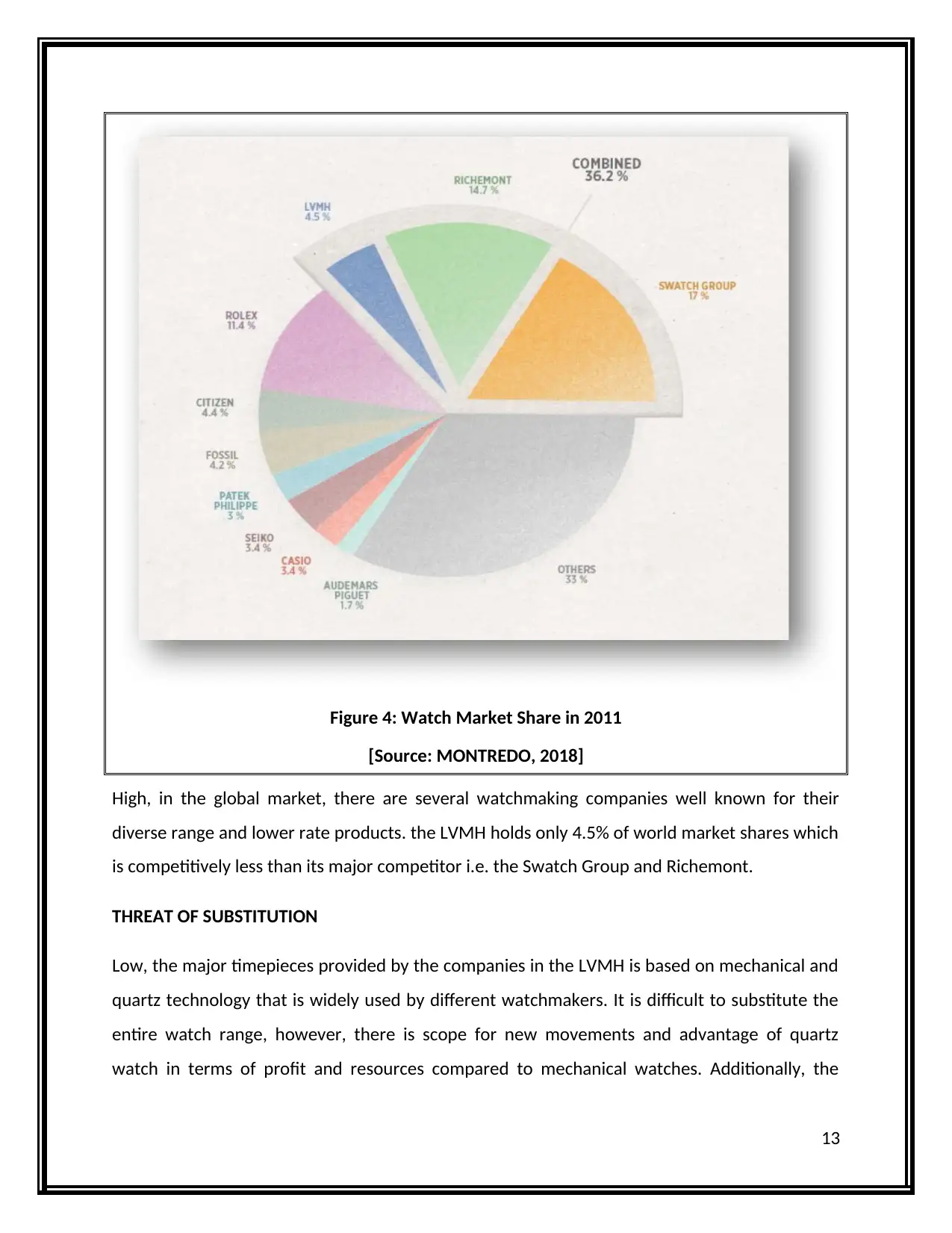
Figure 4: Watch Market Share in 2011
[Source: MONTREDO, 2018]
High, in the global market, there are several watchmaking companies well known for their
diverse range and lower rate products. the LVMH holds only 4.5% of world market shares which
is competitively less than its major competitor i.e. the Swatch Group and Richemont.
THREAT OF SUBSTITUTION
Low, the major timepieces provided by the companies in the LVMH is based on mechanical and
quartz technology that is widely used by different watchmakers. It is difficult to substitute the
entire watch range, however, there is scope for new movements and advantage of quartz
watch in terms of profit and resources compared to mechanical watches. Additionally, the
13
[Source: MONTREDO, 2018]
High, in the global market, there are several watchmaking companies well known for their
diverse range and lower rate products. the LVMH holds only 4.5% of world market shares which
is competitively less than its major competitor i.e. the Swatch Group and Richemont.
THREAT OF SUBSTITUTION
Low, the major timepieces provided by the companies in the LVMH is based on mechanical and
quartz technology that is widely used by different watchmakers. It is difficult to substitute the
entire watch range, however, there is scope for new movements and advantage of quartz
watch in terms of profit and resources compared to mechanical watches. Additionally, the
13
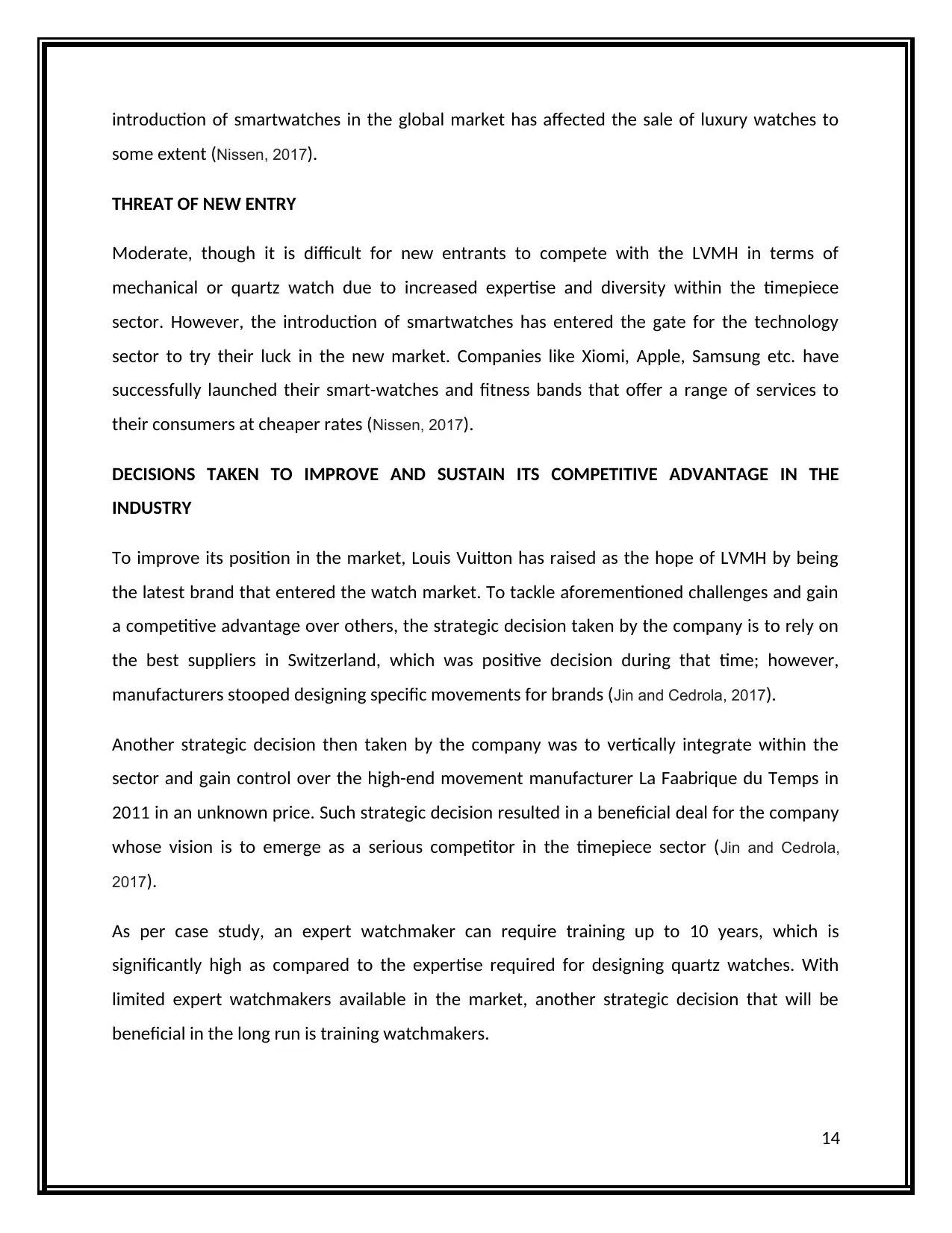
introduction of smartwatches in the global market has affected the sale of luxury watches to
some extent (Nissen, 2017).
THREAT OF NEW ENTRY
Moderate, though it is difficult for new entrants to compete with the LVMH in terms of
mechanical or quartz watch due to increased expertise and diversity within the timepiece
sector. However, the introduction of smartwatches has entered the gate for the technology
sector to try their luck in the new market. Companies like Xiomi, Apple, Samsung etc. have
successfully launched their smart-watches and fitness bands that offer a range of services to
their consumers at cheaper rates (Nissen, 2017).
DECISIONS TAKEN TO IMPROVE AND SUSTAIN ITS COMPETITIVE ADVANTAGE IN THE
INDUSTRY
To improve its position in the market, Louis Vuitton has raised as the hope of LVMH by being
the latest brand that entered the watch market. To tackle aforementioned challenges and gain
a competitive advantage over others, the strategic decision taken by the company is to rely on
the best suppliers in Switzerland, which was positive decision during that time; however,
manufacturers stooped designing specific movements for brands (Jin and Cedrola, 2017).
Another strategic decision then taken by the company was to vertically integrate within the
sector and gain control over the high-end movement manufacturer La Faabrique du Temps in
2011 in an unknown price. Such strategic decision resulted in a beneficial deal for the company
whose vision is to emerge as a serious competitor in the timepiece sector (Jin and Cedrola,
2017).
As per case study, an expert watchmaker can require training up to 10 years, which is
significantly high as compared to the expertise required for designing quartz watches. With
limited expert watchmakers available in the market, another strategic decision that will be
beneficial in the long run is training watchmakers.
14
some extent (Nissen, 2017).
THREAT OF NEW ENTRY
Moderate, though it is difficult for new entrants to compete with the LVMH in terms of
mechanical or quartz watch due to increased expertise and diversity within the timepiece
sector. However, the introduction of smartwatches has entered the gate for the technology
sector to try their luck in the new market. Companies like Xiomi, Apple, Samsung etc. have
successfully launched their smart-watches and fitness bands that offer a range of services to
their consumers at cheaper rates (Nissen, 2017).
DECISIONS TAKEN TO IMPROVE AND SUSTAIN ITS COMPETITIVE ADVANTAGE IN THE
INDUSTRY
To improve its position in the market, Louis Vuitton has raised as the hope of LVMH by being
the latest brand that entered the watch market. To tackle aforementioned challenges and gain
a competitive advantage over others, the strategic decision taken by the company is to rely on
the best suppliers in Switzerland, which was positive decision during that time; however,
manufacturers stooped designing specific movements for brands (Jin and Cedrola, 2017).
Another strategic decision then taken by the company was to vertically integrate within the
sector and gain control over the high-end movement manufacturer La Faabrique du Temps in
2011 in an unknown price. Such strategic decision resulted in a beneficial deal for the company
whose vision is to emerge as a serious competitor in the timepiece sector (Jin and Cedrola,
2017).
As per case study, an expert watchmaker can require training up to 10 years, which is
significantly high as compared to the expertise required for designing quartz watches. With
limited expert watchmakers available in the market, another strategic decision that will be
beneficial in the long run is training watchmakers.
14
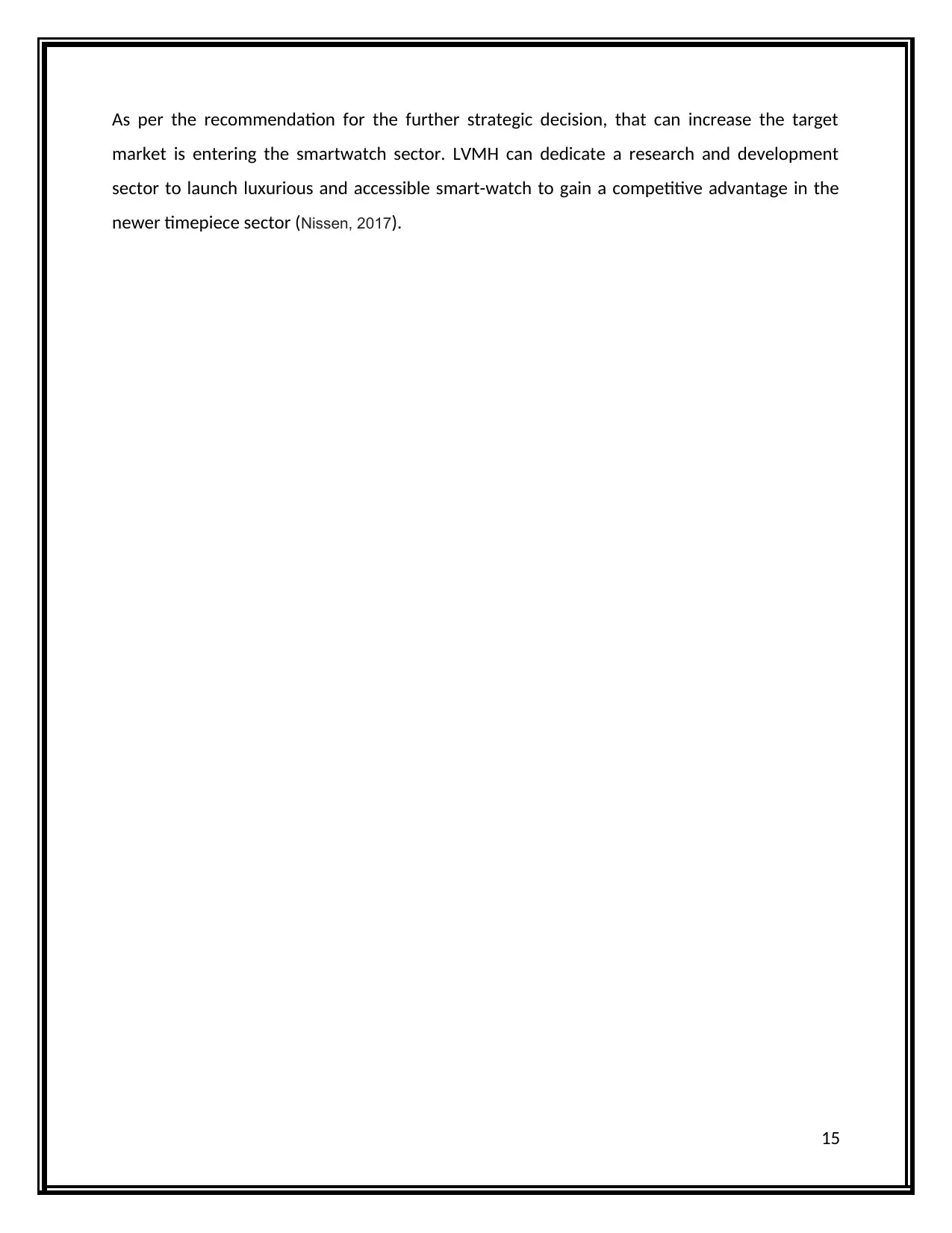
As per the recommendation for the further strategic decision, that can increase the target
market is entering the smartwatch sector. LVMH can dedicate a research and development
sector to launch luxurious and accessible smart-watch to gain a competitive advantage in the
newer timepiece sector (Nissen, 2017).
15
market is entering the smartwatch sector. LVMH can dedicate a research and development
sector to launch luxurious and accessible smart-watch to gain a competitive advantage in the
newer timepiece sector (Nissen, 2017).
15
Secure Best Marks with AI Grader
Need help grading? Try our AI Grader for instant feedback on your assignments.
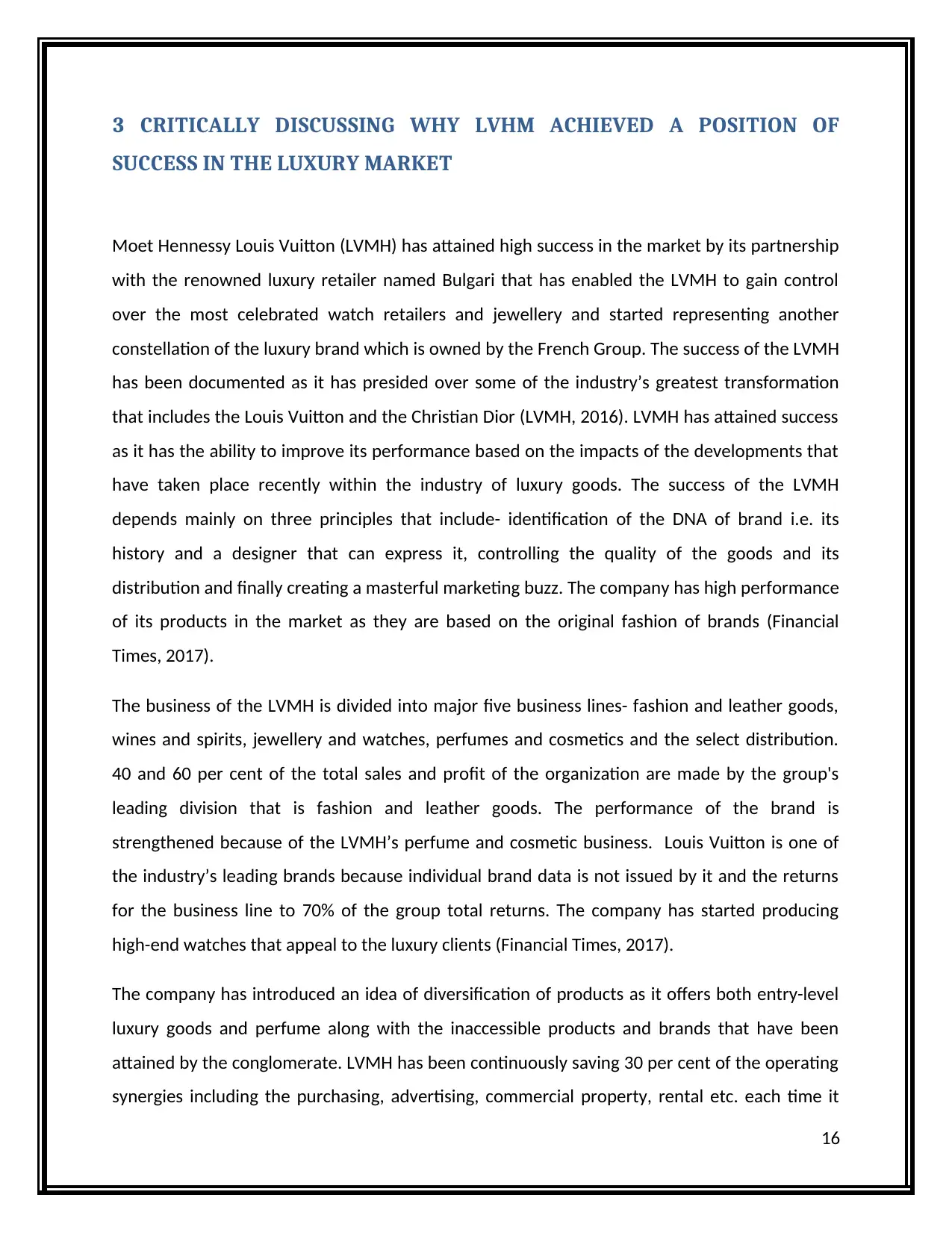
3 CRITICALLY DISCUSSING WHY LVHM ACHIEVED A POSITION OF
SUCCESS IN THE LUXURY MARKET
Moet Hennessy Louis Vuitton (LVMH) has attained high success in the market by its partnership
with the renowned luxury retailer named Bulgari that has enabled the LVMH to gain control
over the most celebrated watch retailers and jewellery and started representing another
constellation of the luxury brand which is owned by the French Group. The success of the LVMH
has been documented as it has presided over some of the industry’s greatest transformation
that includes the Louis Vuitton and the Christian Dior (LVMH, 2016). LVMH has attained success
as it has the ability to improve its performance based on the impacts of the developments that
have taken place recently within the industry of luxury goods. The success of the LVMH
depends mainly on three principles that include- identification of the DNA of brand i.e. its
history and a designer that can express it, controlling the quality of the goods and its
distribution and finally creating a masterful marketing buzz. The company has high performance
of its products in the market as they are based on the original fashion of brands (Financial
Times, 2017).
The business of the LVMH is divided into major five business lines- fashion and leather goods,
wines and spirits, jewellery and watches, perfumes and cosmetics and the select distribution.
40 and 60 per cent of the total sales and profit of the organization are made by the group's
leading division that is fashion and leather goods. The performance of the brand is
strengthened because of the LVMH’s perfume and cosmetic business. Louis Vuitton is one of
the industry’s leading brands because individual brand data is not issued by it and the returns
for the business line to 70% of the group total returns. The company has started producing
high-end watches that appeal to the luxury clients (Financial Times, 2017).
The company has introduced an idea of diversification of products as it offers both entry-level
luxury goods and perfume along with the inaccessible products and brands that have been
attained by the conglomerate. LVMH has been continuously saving 30 per cent of the operating
synergies including the purchasing, advertising, commercial property, rental etc. each time it
16
SUCCESS IN THE LUXURY MARKET
Moet Hennessy Louis Vuitton (LVMH) has attained high success in the market by its partnership
with the renowned luxury retailer named Bulgari that has enabled the LVMH to gain control
over the most celebrated watch retailers and jewellery and started representing another
constellation of the luxury brand which is owned by the French Group. The success of the LVMH
has been documented as it has presided over some of the industry’s greatest transformation
that includes the Louis Vuitton and the Christian Dior (LVMH, 2016). LVMH has attained success
as it has the ability to improve its performance based on the impacts of the developments that
have taken place recently within the industry of luxury goods. The success of the LVMH
depends mainly on three principles that include- identification of the DNA of brand i.e. its
history and a designer that can express it, controlling the quality of the goods and its
distribution and finally creating a masterful marketing buzz. The company has high performance
of its products in the market as they are based on the original fashion of brands (Financial
Times, 2017).
The business of the LVMH is divided into major five business lines- fashion and leather goods,
wines and spirits, jewellery and watches, perfumes and cosmetics and the select distribution.
40 and 60 per cent of the total sales and profit of the organization are made by the group's
leading division that is fashion and leather goods. The performance of the brand is
strengthened because of the LVMH’s perfume and cosmetic business. Louis Vuitton is one of
the industry’s leading brands because individual brand data is not issued by it and the returns
for the business line to 70% of the group total returns. The company has started producing
high-end watches that appeal to the luxury clients (Financial Times, 2017).
The company has introduced an idea of diversification of products as it offers both entry-level
luxury goods and perfume along with the inaccessible products and brands that have been
attained by the conglomerate. LVMH has been continuously saving 30 per cent of the operating
synergies including the purchasing, advertising, commercial property, rental etc. each time it
16
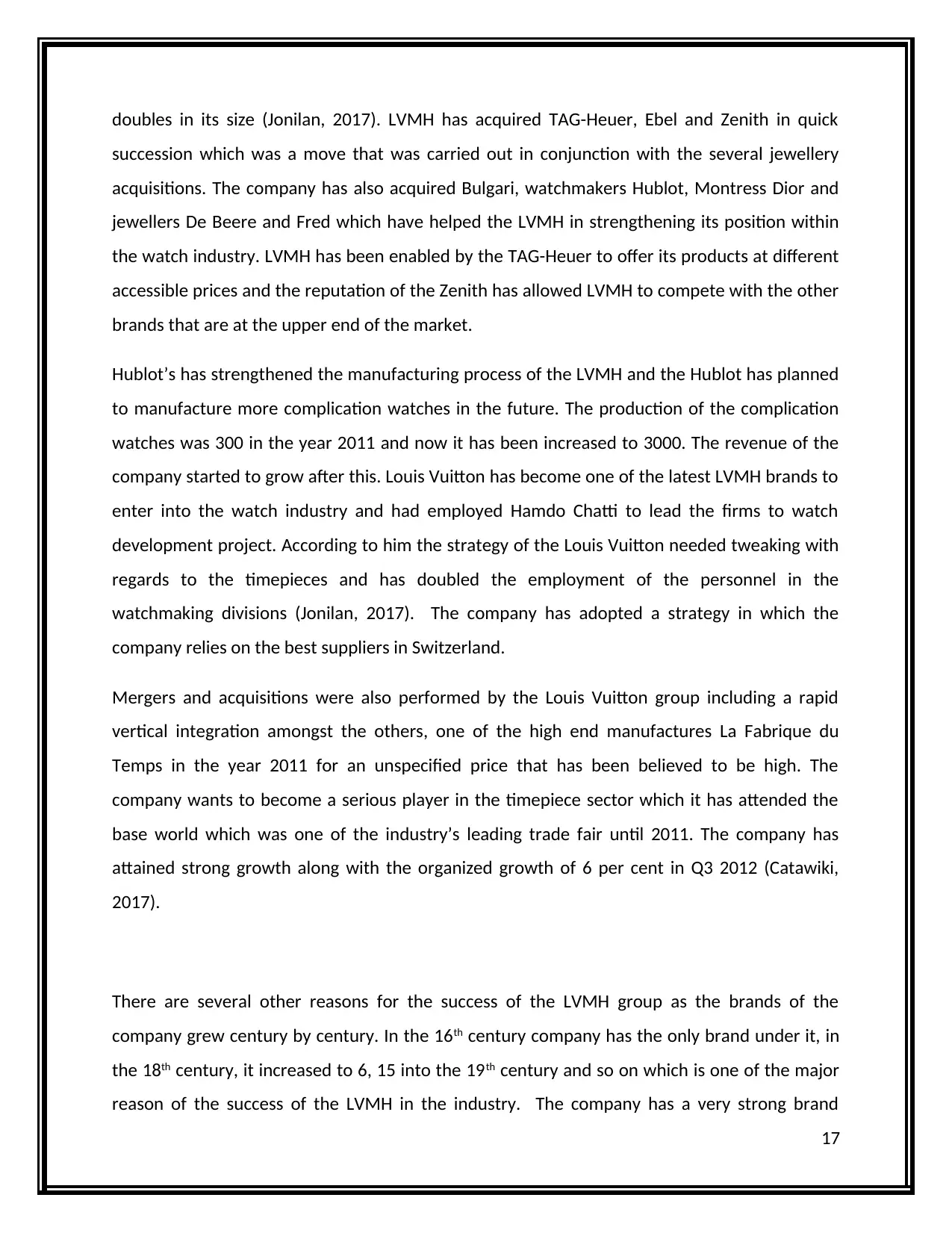
doubles in its size (Jonilan, 2017). LVMH has acquired TAG-Heuer, Ebel and Zenith in quick
succession which was a move that was carried out in conjunction with the several jewellery
acquisitions. The company has also acquired Bulgari, watchmakers Hublot, Montress Dior and
jewellers De Beere and Fred which have helped the LVMH in strengthening its position within
the watch industry. LVMH has been enabled by the TAG-Heuer to offer its products at different
accessible prices and the reputation of the Zenith has allowed LVMH to compete with the other
brands that are at the upper end of the market.
Hublot’s has strengthened the manufacturing process of the LVMH and the Hublot has planned
to manufacture more complication watches in the future. The production of the complication
watches was 300 in the year 2011 and now it has been increased to 3000. The revenue of the
company started to grow after this. Louis Vuitton has become one of the latest LVMH brands to
enter into the watch industry and had employed Hamdo Chatti to lead the firms to watch
development project. According to him the strategy of the Louis Vuitton needed tweaking with
regards to the timepieces and has doubled the employment of the personnel in the
watchmaking divisions (Jonilan, 2017). The company has adopted a strategy in which the
company relies on the best suppliers in Switzerland.
Mergers and acquisitions were also performed by the Louis Vuitton group including a rapid
vertical integration amongst the others, one of the high end manufactures La Fabrique du
Temps in the year 2011 for an unspecified price that has been believed to be high. The
company wants to become a serious player in the timepiece sector which it has attended the
base world which was one of the industry’s leading trade fair until 2011. The company has
attained strong growth along with the organized growth of 6 per cent in Q3 2012 (Catawiki,
2017).
There are several other reasons for the success of the LVMH group as the brands of the
company grew century by century. In the 16th century company has the only brand under it, in
the 18th century, it increased to 6, 15 into the 19th century and so on which is one of the major
reason of the success of the LVMH in the industry. The company has a very strong brand
17
succession which was a move that was carried out in conjunction with the several jewellery
acquisitions. The company has also acquired Bulgari, watchmakers Hublot, Montress Dior and
jewellers De Beere and Fred which have helped the LVMH in strengthening its position within
the watch industry. LVMH has been enabled by the TAG-Heuer to offer its products at different
accessible prices and the reputation of the Zenith has allowed LVMH to compete with the other
brands that are at the upper end of the market.
Hublot’s has strengthened the manufacturing process of the LVMH and the Hublot has planned
to manufacture more complication watches in the future. The production of the complication
watches was 300 in the year 2011 and now it has been increased to 3000. The revenue of the
company started to grow after this. Louis Vuitton has become one of the latest LVMH brands to
enter into the watch industry and had employed Hamdo Chatti to lead the firms to watch
development project. According to him the strategy of the Louis Vuitton needed tweaking with
regards to the timepieces and has doubled the employment of the personnel in the
watchmaking divisions (Jonilan, 2017). The company has adopted a strategy in which the
company relies on the best suppliers in Switzerland.
Mergers and acquisitions were also performed by the Louis Vuitton group including a rapid
vertical integration amongst the others, one of the high end manufactures La Fabrique du
Temps in the year 2011 for an unspecified price that has been believed to be high. The
company wants to become a serious player in the timepiece sector which it has attended the
base world which was one of the industry’s leading trade fair until 2011. The company has
attained strong growth along with the organized growth of 6 per cent in Q3 2012 (Catawiki,
2017).
There are several other reasons for the success of the LVMH group as the brands of the
company grew century by century. In the 16th century company has the only brand under it, in
the 18th century, it increased to 6, 15 into the 19th century and so on which is one of the major
reason of the success of the LVMH in the industry. The company has a very strong brand
17
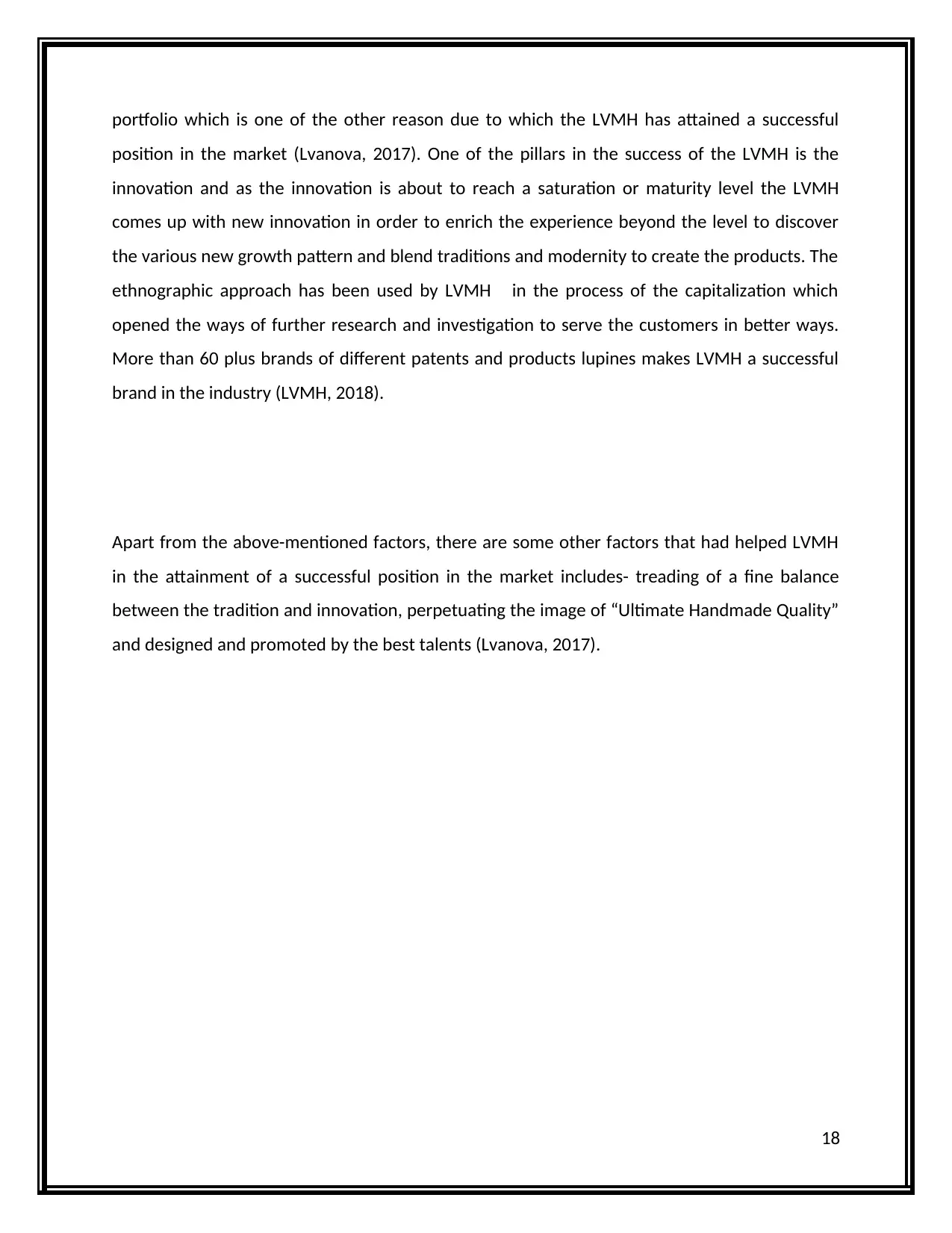
portfolio which is one of the other reason due to which the LVMH has attained a successful
position in the market (Lvanova, 2017). One of the pillars in the success of the LVMH is the
innovation and as the innovation is about to reach a saturation or maturity level the LVMH
comes up with new innovation in order to enrich the experience beyond the level to discover
the various new growth pattern and blend traditions and modernity to create the products. The
ethnographic approach has been used by LVMH in the process of the capitalization which
opened the ways of further research and investigation to serve the customers in better ways.
More than 60 plus brands of different patents and products lupines makes LVMH a successful
brand in the industry (LVMH, 2018).
Apart from the above-mentioned factors, there are some other factors that had helped LVMH
in the attainment of a successful position in the market includes- treading of a fine balance
between the tradition and innovation, perpetuating the image of “Ultimate Handmade Quality”
and designed and promoted by the best talents (Lvanova, 2017).
18
position in the market (Lvanova, 2017). One of the pillars in the success of the LVMH is the
innovation and as the innovation is about to reach a saturation or maturity level the LVMH
comes up with new innovation in order to enrich the experience beyond the level to discover
the various new growth pattern and blend traditions and modernity to create the products. The
ethnographic approach has been used by LVMH in the process of the capitalization which
opened the ways of further research and investigation to serve the customers in better ways.
More than 60 plus brands of different patents and products lupines makes LVMH a successful
brand in the industry (LVMH, 2018).
Apart from the above-mentioned factors, there are some other factors that had helped LVMH
in the attainment of a successful position in the market includes- treading of a fine balance
between the tradition and innovation, perpetuating the image of “Ultimate Handmade Quality”
and designed and promoted by the best talents (Lvanova, 2017).
18
Paraphrase This Document
Need a fresh take? Get an instant paraphrase of this document with our AI Paraphraser
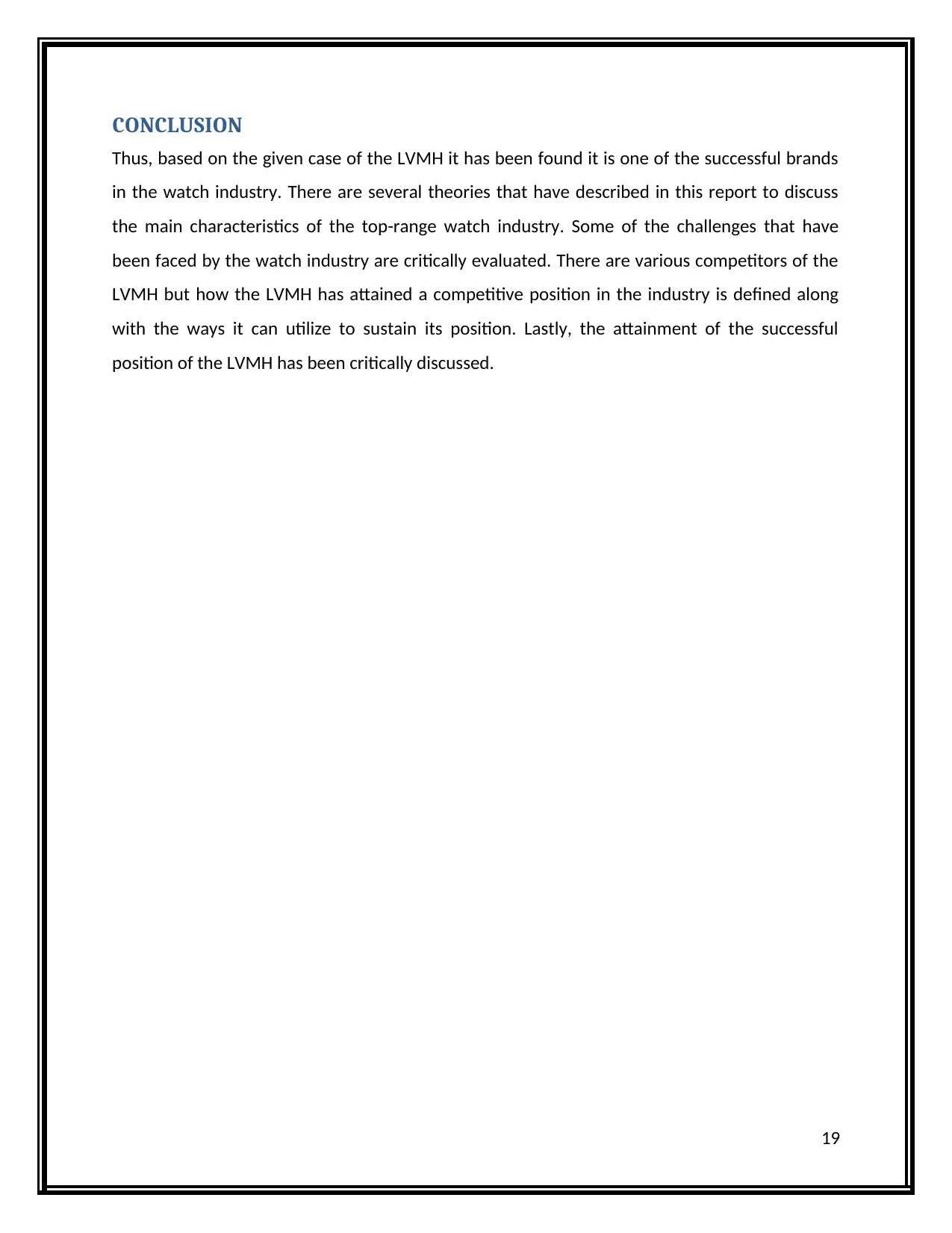
CONCLUSION
Thus, based on the given case of the LVMH it has been found it is one of the successful brands
in the watch industry. There are several theories that have described in this report to discuss
the main characteristics of the top-range watch industry. Some of the challenges that have
been faced by the watch industry are critically evaluated. There are various competitors of the
LVMH but how the LVMH has attained a competitive position in the industry is defined along
with the ways it can utilize to sustain its position. Lastly, the attainment of the successful
position of the LVMH has been critically discussed.
19
Thus, based on the given case of the LVMH it has been found it is one of the successful brands
in the watch industry. There are several theories that have described in this report to discuss
the main characteristics of the top-range watch industry. Some of the challenges that have
been faced by the watch industry are critically evaluated. There are various competitors of the
LVMH but how the LVMH has attained a competitive position in the industry is defined along
with the ways it can utilize to sustain its position. Lastly, the attainment of the successful
position of the LVMH has been critically discussed.
19
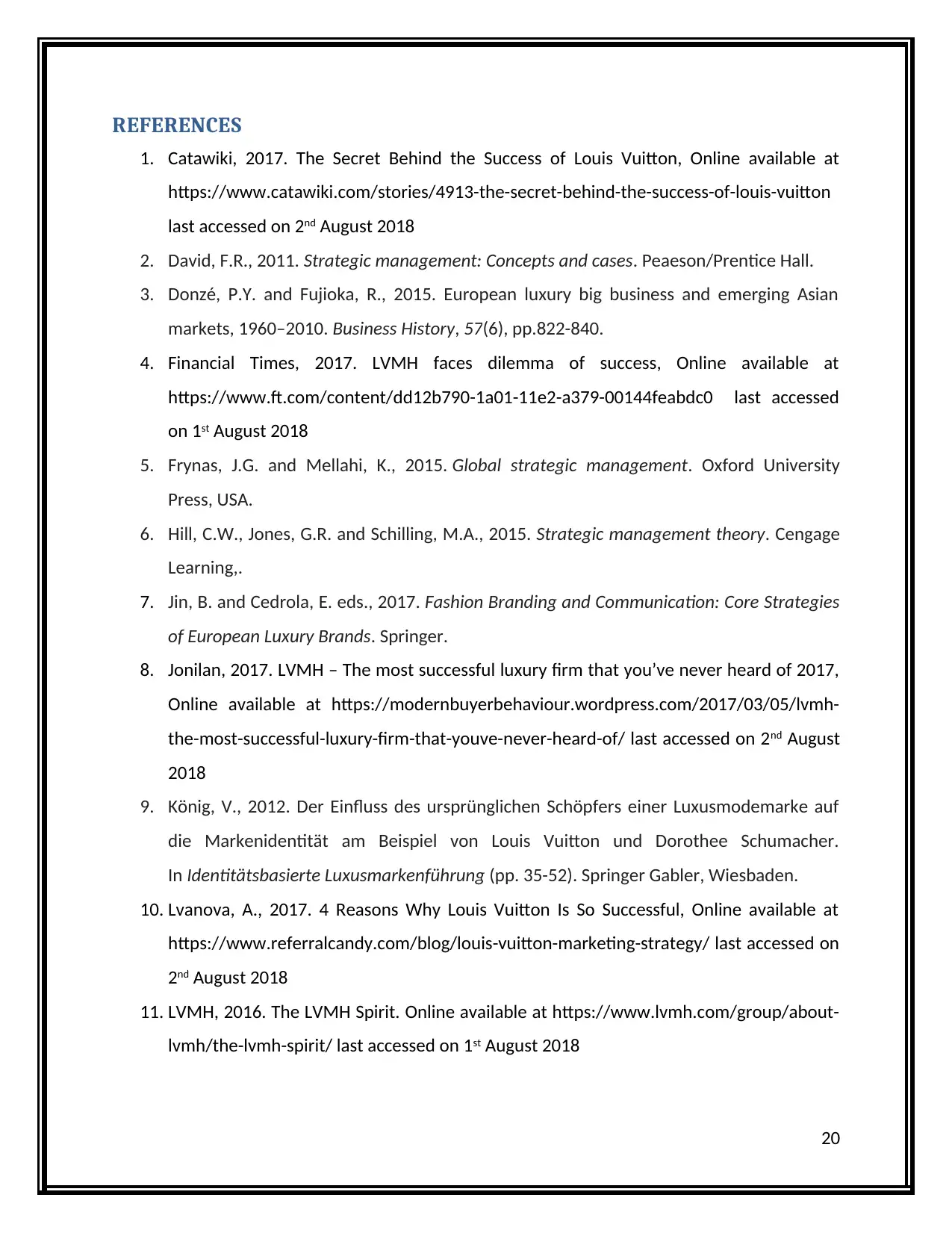
REFERENCES
1. Catawiki, 2017. The Secret Behind the Success of Louis Vuitton, Online available at
https://www.catawiki.com/stories/4913-the-secret-behind-the-success-of-louis-vuitton
last accessed on 2nd August 2018
2. David, F.R., 2011. Strategic management: Concepts and cases. Peaeson/Prentice Hall.
3. Donzé, P.Y. and Fujioka, R., 2015. European luxury big business and emerging Asian
markets, 1960–2010. Business History, 57(6), pp.822-840.
4. Financial Times, 2017. LVMH faces dilemma of success, Online available at
https://www.ft.com/content/dd12b790-1a01-11e2-a379-00144feabdc0 last accessed
on 1st August 2018
5. Frynas, J.G. and Mellahi, K., 2015. Global strategic management. Oxford University
Press, USA.
6. Hill, C.W., Jones, G.R. and Schilling, M.A., 2015. Strategic management theory. Cengage
Learning,.
7. Jin, B. and Cedrola, E. eds., 2017. Fashion Branding and Communication: Core Strategies
of European Luxury Brands. Springer.
8. Jonilan, 2017. LVMH – The most successful luxury firm that you’ve never heard of 2017,
Online available at https://modernbuyerbehaviour.wordpress.com/2017/03/05/lvmh-
the-most-successful-luxury-firm-that-youve-never-heard-of/ last accessed on 2nd August
2018
9. König, V., 2012. Der Einfluss des ursprünglichen Schöpfers einer Luxusmodemarke auf
die Markenidentität am Beispiel von Louis Vuitton und Dorothee Schumacher.
In Identitätsbasierte Luxusmarkenführung (pp. 35-52). Springer Gabler, Wiesbaden.
10. Lvanova, A., 2017. 4 Reasons Why Louis Vuitton Is So Successful, Online available at
https://www.referralcandy.com/blog/louis-vuitton-marketing-strategy/ last accessed on
2nd August 2018
11. LVMH, 2016. The LVMH Spirit. Online available at https://www.lvmh.com/group/about-
lvmh/the-lvmh-spirit/ last accessed on 1st August 2018
20
1. Catawiki, 2017. The Secret Behind the Success of Louis Vuitton, Online available at
https://www.catawiki.com/stories/4913-the-secret-behind-the-success-of-louis-vuitton
last accessed on 2nd August 2018
2. David, F.R., 2011. Strategic management: Concepts and cases. Peaeson/Prentice Hall.
3. Donzé, P.Y. and Fujioka, R., 2015. European luxury big business and emerging Asian
markets, 1960–2010. Business History, 57(6), pp.822-840.
4. Financial Times, 2017. LVMH faces dilemma of success, Online available at
https://www.ft.com/content/dd12b790-1a01-11e2-a379-00144feabdc0 last accessed
on 1st August 2018
5. Frynas, J.G. and Mellahi, K., 2015. Global strategic management. Oxford University
Press, USA.
6. Hill, C.W., Jones, G.R. and Schilling, M.A., 2015. Strategic management theory. Cengage
Learning,.
7. Jin, B. and Cedrola, E. eds., 2017. Fashion Branding and Communication: Core Strategies
of European Luxury Brands. Springer.
8. Jonilan, 2017. LVMH – The most successful luxury firm that you’ve never heard of 2017,
Online available at https://modernbuyerbehaviour.wordpress.com/2017/03/05/lvmh-
the-most-successful-luxury-firm-that-youve-never-heard-of/ last accessed on 2nd August
2018
9. König, V., 2012. Der Einfluss des ursprünglichen Schöpfers einer Luxusmodemarke auf
die Markenidentität am Beispiel von Louis Vuitton und Dorothee Schumacher.
In Identitätsbasierte Luxusmarkenführung (pp. 35-52). Springer Gabler, Wiesbaden.
10. Lvanova, A., 2017. 4 Reasons Why Louis Vuitton Is So Successful, Online available at
https://www.referralcandy.com/blog/louis-vuitton-marketing-strategy/ last accessed on
2nd August 2018
11. LVMH, 2016. The LVMH Spirit. Online available at https://www.lvmh.com/group/about-
lvmh/the-lvmh-spirit/ last accessed on 1st August 2018
20
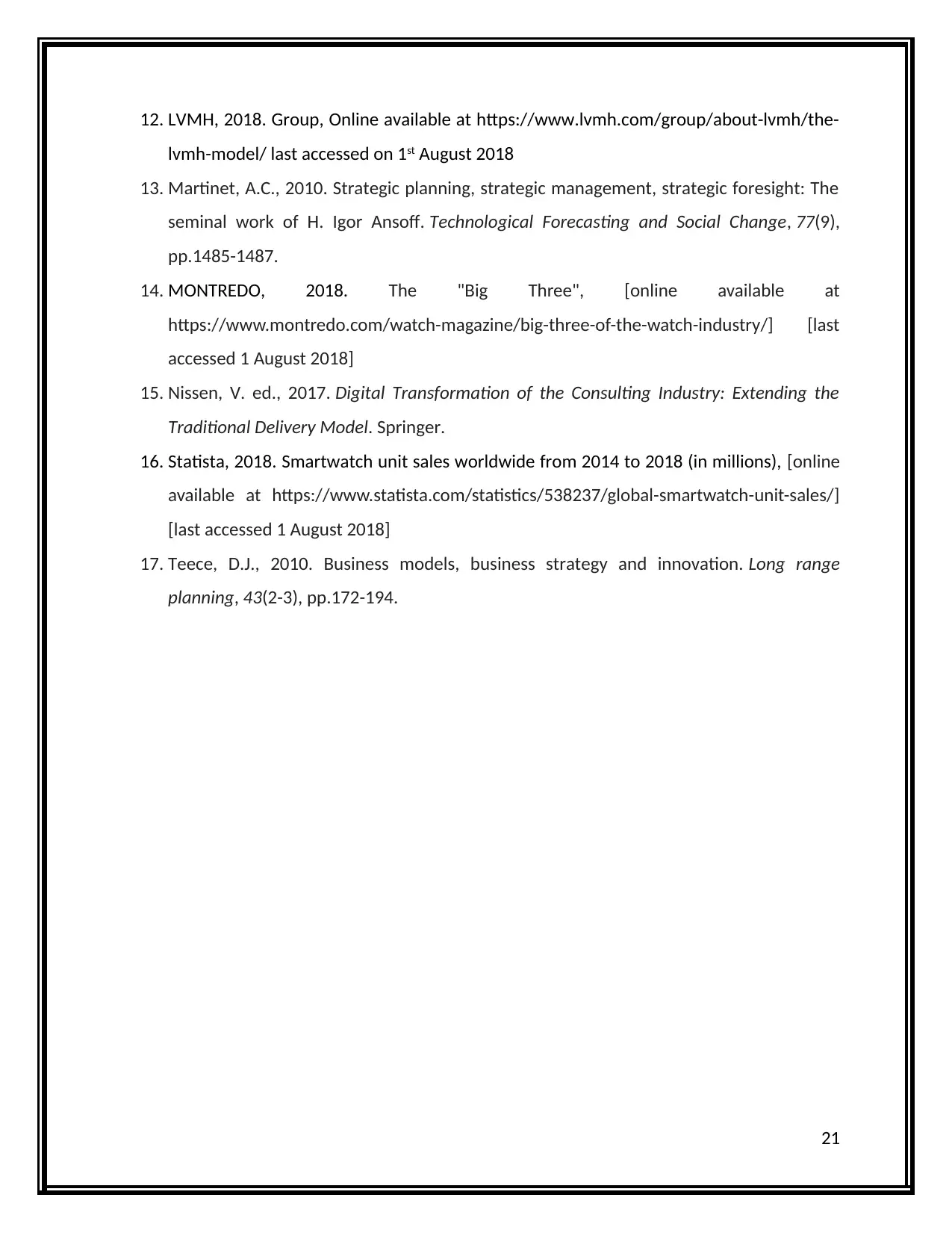
12. LVMH, 2018. Group, Online available at https://www.lvmh.com/group/about-lvmh/the-
lvmh-model/ last accessed on 1st August 2018
13. Martinet, A.C., 2010. Strategic planning, strategic management, strategic foresight: The
seminal work of H. Igor Ansoff. Technological Forecasting and Social Change, 77(9),
pp.1485-1487.
14. MONTREDO, 2018. The "Big Three", [online available at
https://www.montredo.com/watch-magazine/big-three-of-the-watch-industry/] [last
accessed 1 August 2018]
15. Nissen, V. ed., 2017. Digital Transformation of the Consulting Industry: Extending the
Traditional Delivery Model. Springer.
16. Statista, 2018. Smartwatch unit sales worldwide from 2014 to 2018 (in millions), [online
available at https://www.statista.com/statistics/538237/global-smartwatch-unit-sales/]
[last accessed 1 August 2018]
17. Teece, D.J., 2010. Business models, business strategy and innovation. Long range
planning, 43(2-3), pp.172-194.
21
lvmh-model/ last accessed on 1st August 2018
13. Martinet, A.C., 2010. Strategic planning, strategic management, strategic foresight: The
seminal work of H. Igor Ansoff. Technological Forecasting and Social Change, 77(9),
pp.1485-1487.
14. MONTREDO, 2018. The "Big Three", [online available at
https://www.montredo.com/watch-magazine/big-three-of-the-watch-industry/] [last
accessed 1 August 2018]
15. Nissen, V. ed., 2017. Digital Transformation of the Consulting Industry: Extending the
Traditional Delivery Model. Springer.
16. Statista, 2018. Smartwatch unit sales worldwide from 2014 to 2018 (in millions), [online
available at https://www.statista.com/statistics/538237/global-smartwatch-unit-sales/]
[last accessed 1 August 2018]
17. Teece, D.J., 2010. Business models, business strategy and innovation. Long range
planning, 43(2-3), pp.172-194.
21
1 out of 22
Related Documents
Your All-in-One AI-Powered Toolkit for Academic Success.
+13062052269
info@desklib.com
Available 24*7 on WhatsApp / Email
![[object Object]](/_next/static/media/star-bottom.7253800d.svg)
Unlock your academic potential
© 2024 | Zucol Services PVT LTD | All rights reserved.





